Introduction
The Trident I C-4 Submarine-Launched Ballistic Missile (SLBM) initially referred to as EXPO (extended range POSEIDON) was designed to supplant the Poseidon/Polaris missiles.
Development began in 1971, culminating in a missile that offered increased range capability over its predecessor, the Poseidon C3, with approximately the same physical size. The Trident I, a three-stage, solid propellant missile, boasted advanced propellants, electronics, and materials, enabling a range exceeding 4,000 nautical miles with a full payload. Equipped with multiple independently targetable reentry vehicles (MIRVs), it could strike several targets simultaneously.
This capability, coupled with its deployment in both the new Trident submarine (Ohio 726 class) and backfitted Poseidon submarines, significantly expanded the operational range of the U.S. submarine fleet. The first Trident submarine was deployed in 1982, and the system’s introduction led to the phased retirement of Poseidon submarines, in line with strategic arms limitation agreements.
About this Timeline
The journey of the Trident I C-4 commenced in December 1971 with its development start, advancing to engineering development by February 1973. The first tactical patrol with a Trident-backfitted Poseidon submarine took place in October 1979. Subsequently, the first Ohio-class Trident submarine was deployed in September 1982 from Bangor, Washington.
This comprehensive chronology details the development and operational history of the Trident I C4 since the 1960s. The text is adapted from the “FBM Facts/chronology: Polaris, Poseidon, Trident,” published by the U.S. Navy’s Strategic Systems Program Office.
1960s
1966
1 NOVEMBER 1966
- The Secretary of Defense initiated a comprehensive study effort termed STRAT-X to examine future ballistic missile basing concepts and missile performance characteristics required to counter potential Soviet strategic offensive forces and ABM proliferation.
1967
AUGUST 1967
- STRAT-X study report promulgated. It indicated the need for the advanced sea-based strategic missile generated around a new submersible platform, the undersea long-range missile system(ULMS).
1968
1 FEBRUARY 1968
- The advanced development objective for an Undersea Long Range Missile System (ULMS) was established by the Chief of Naval Operations.
1969
4 OCTOBER 1969
- The Chief of Naval Operations established the Undersea Long Range Missile System (ULMS) program.
1970s
1970
26 MARCH 1970
- ULMS Program Steering and Working Groups established. The Steering Group was established to provide program guidance, a forum for program problems, and periodic evaluation of program progress. The Working Group was established to derive a list of key events, solve problems monitor progress, and ensure continuous and effective communication.
1971
31 MARCH 1971
- The ULMS Project Manager (PM-2) was established under the Chief of Naval Material.
DECEMBER 1971
- Undersea Long-Range Missile development contract awarded.
1972
16 MAY 1972
- The Secretary of Defense approved the proposal by the Secretary of the Navy to rename the ULMS program as the TRIDENT program.
MAY 1972
- Accuracy ULM technical program planning phase completed.
1973
16 FEBRUARY 1973
- The Secretary of the Navy announced the selection of Bangor, Washington, as the initial base for TRIDENT operations.
15 NOVEMBER 1973
- The President signed the FY 74 Appropriation Authorization Act providing funds for the first TRIDENT submarine.
14 DECEMBER 1973
- The president approved TRIDENT for inclusion in the BRICKBAT priority of the Master Urgency List. This is the highest industrial priority for defense projects.
1974
6 MARCH 1974
- The first flight in support of the C-4 Mk 4 Supplemental Flight Test Program was conducted from Vandenberg Air Force Base.
14 MARCH 1974
- TRIDENT-I (C-4) technical program approval was granted.
1 MAY 1974
- The second flight in the C-4 MK 4 Supplemental Flight Test Program was conducted from Vandenberg Air Force Base.
28 JUNE 1974
- The third flight in support of the C-4 MK 4 Supplemental Flight Test Program was conducted from Vandenberg Air Force Base.
25 JULY 1974
- The Navy awarded a fixed-price incentive contract to General Dynamics Electric Boat Division for the construction of the first TRIDENT submarine. The contract included an option for the construction of three additional TRIDENT submarines.
19 AUGUST 1974
- OSDP contract awarded to LMSC for missile system development plus the production of the first missiles, including re-entry body shells. The contract provided for support equipment and technical services to outfit and support the operation of TRIDENT-I and back-fit submarines, SWFPAC, POMFLANT, and training facilities.
1975
10 JANUARY 1975
- TRIDENT submarine production decision regarding the Navy’s recommendation of full production go-ahead.
28 FEBRUARY 1975
- The Navy exercised the contract option for the construction of the second and third TRIDENT submarines
9 MAY 1975
- The second Supplement Flight Test of the advanced development MK 500 Evader re-entry body was conducted from Vandenberg Air Force Base.
22 AUGUST 1975
- The third Supplemental Flight Test with the MK 500 Evader was successfully launched from Vandenberg Air Force Base.
30 SEPTEMBER 1975
- The fifth C-4 MK 4 Supplemental Flight Test (SFT-05) was conducted from Vandenberg Air Force Base.
13 NOVEMBER 1975
- The sixth and final C-4 MK 4 Supplemental Flight Test (SPT-06) was conducted from Vandenberg Air Force Base.
1976
23 JANUARY 1976
- The fifth Supplemental Flight Test (SFT 105) of the MK 500 Evader re-entry body was conducted from Vandenberg Air Force Base.
20 FEBRUARY 1976
- The contract option for the construction of the fourth TRIDENT submarine was exercised.
10 APRIL 1976
- The keel laying ceremony for lead TRIDENT Submarine, OHIO (SSBN 726) was held at General Dynamics, Electric Boat Division, Groton, Connecticut. Mrs. Robert Taft, Jr., wife of Senator Taft (R. Ohio) was the sponsor.
10 MAY 1976
- Secretary of the Navy J. William Middendorf II announced that the name of the second TRIDENT submarine would be MICHIGAN.
1977
17 JANUARY 1977
- TRIDENT-I (C-4) production decision regarding the Navy’s recommendation of full production go-ahead.
18 JANUARY 1977
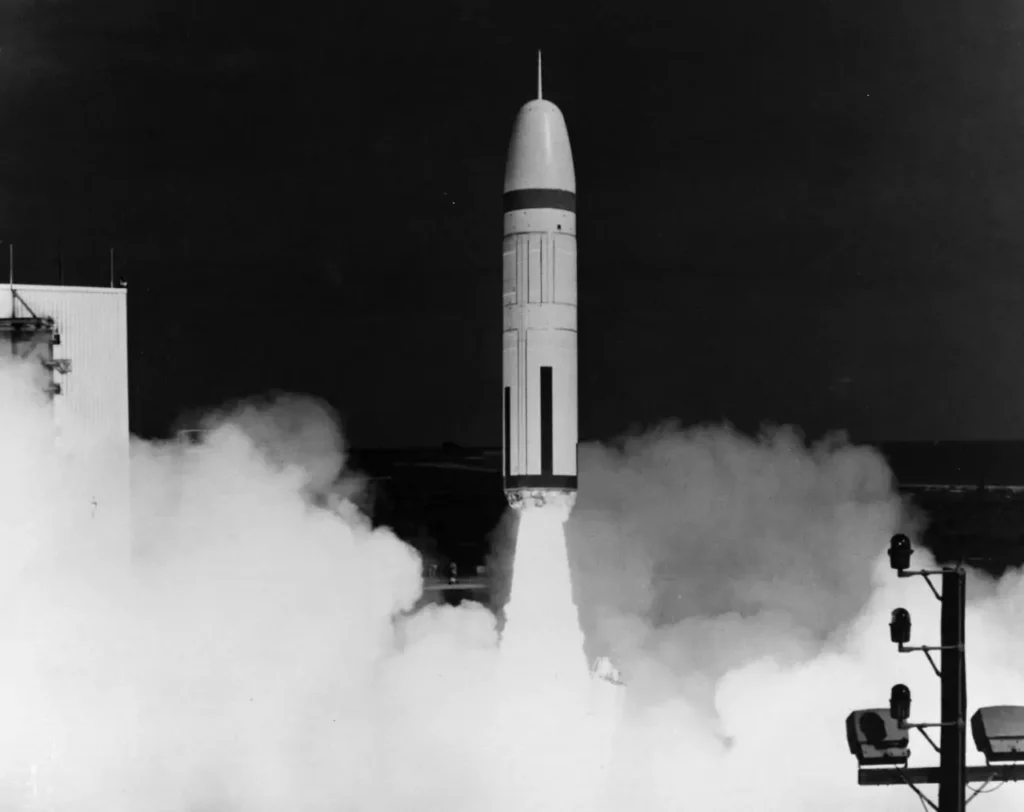
- The first flight test in the TRIDENT-I (C4) development program, C4X-1, was successfully conducted from flat Pad 25C at Cape Canaveral.
3 FEBRUARY 1977
- PEM tender USS SIMON LAKE commenced overhaul at Charleston Naval Shipyard. The overhaul duration for this first tender to be provided with C-4 capability was scheduled for 12 months.
15 FEBRUARY 1977
- The second flight test in the TRIDENT-I (C-4) development program, C4X-2, was successfully conducted from flat Pad 25C at Cape Canaveral.
28 MARCH 1977
- The third flight in the TRIDENT-I (C-4) development program, C4X-3, was successfully conducted from flat Pad 25C at Cape Canaveral.
29 APRIL 1977
- The fourth flight test in the TRIDENT-I (C-4) development program, C4X-6 was successfully conducted from Flat Pad 25C at Cape Canaveral.
6 JUNE 1977
- The Navy awarded a fixed-price incentive contract to General Dynamics Electric Boat Division for the construction of the fifth TRIDENT submarine. The contract included an option for two additional TRIDENT submarines.
27 JUNE 1977
- The fifth flight test in the TRIDENT-I (C-4) development program, C4X-8, was successfully conducted from flat pad 25C at Cape Canaveral.
18 AUGUST 1977
- The sixth flight test in the TRIDENT-I (C-4) development program was successfully conducted from Flat Pad 25C at Cape Canaveral.
3 SEPTEMBER 1977
- The seventh flight test in the TRIDENT-I (C-4) development program was successfully conducted from Flat Pad 25C at Cape Canaveral.
19 OCTOBER 1977
- The eighth flight test In the TRIDENT-I (C-4) development program was successfully conducted from Flat Pad 25C at Cape Canaveral.
5 DECEMBER 1977
- The ninth flight test in the TRIDENT-l (C-4) development program was successfully conducted from Flat Pad 25C at Cape Canaveral.
1978
17 JANUARY 1978
- The 10th flight test in the TRIDENT-I (C4) development program was successfully conducted from Flat Pad 25C at Cape Canaveral.
4 FEBRUARY 1978
- FBM tender USS SIMON LAKE (AS 33) completed C-3/C-4 overhaul at Charleston Naval shipyard. Overhaul duration was 12 months.
14 FEBRUARY 1978
- The 11th flight test in the TRIDENT-I (C-4) development program was conducted from Flat Pad 25C at Cape Canaveral.
27 FEBRUARY 1978
- The Navy exercised the contract option for the construction of the sixth and seventh TRIDENT submarines.
12 APRIL 1978
- The 12th flight test in the TRIDENT (C4) development program (C4X-15) was successfully conducted from Flat Pad 25C at Cape Canaveral, FL. A joint Navy/Air Force recovery team retrieved the expended first-stage motor for use in a motor evaluation program.
19 MAY 1978
- The contractor for TRIDENT I (C4) missile development, Lockheed Missiles & Space Co., Inc., proposed that the number of development flight tests be reduced from 30 to 25.
22 JUNE 1978
- The 13th flight test in the TRIDENT (C4) development program (C4X-17) was successfully conducted from Flat Pad 25C at Cape Canaveral, FL.
13 JULY 1978
- The expended second-stage motor from TRIDENT I (C4) development flight test, C4X-12, which was conducted on 5 December 1977, was found washed up on the shore of a small island in the Bahamas. The motor was recovered and returned to the vendor for inspection.
10 AUGUST 1978
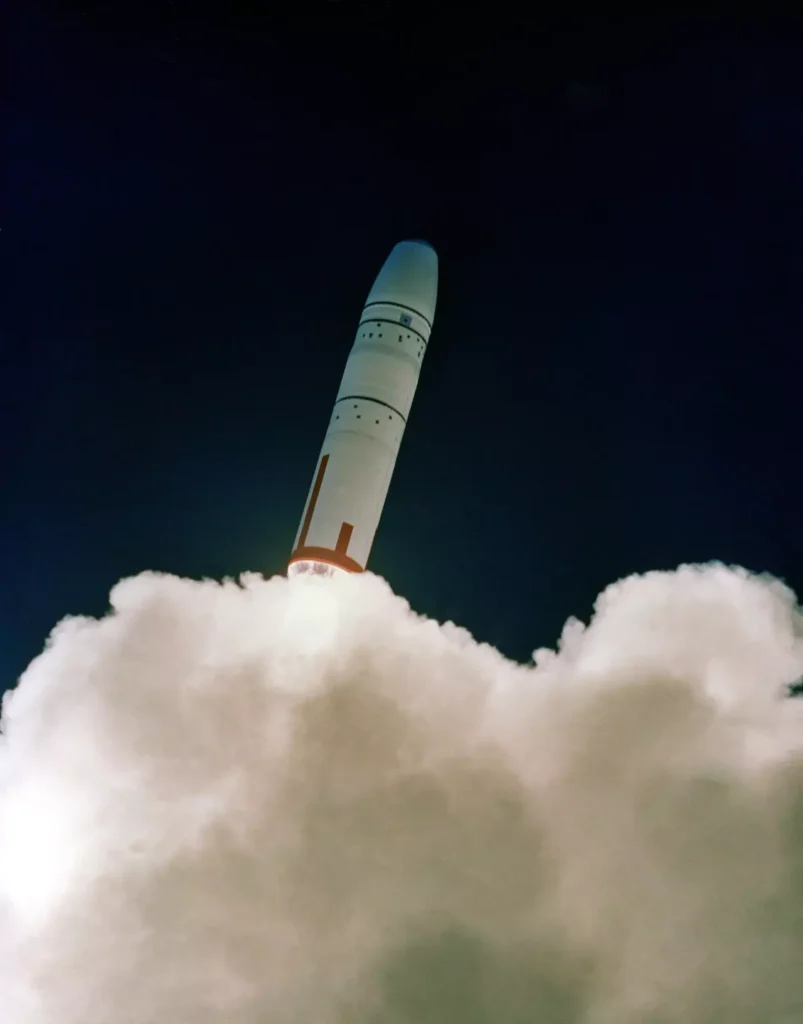
- The 14th flight test in the TRIDENT (C4) development program (C4X-18) was successfully conducted from Flat Pad 25C at Cape Canaveral, FL.
22 SEPTEMBER 1978
- USS FRANCIS SCOTT KEY (SSBN 657) entered drydock at the FBM Support Site, Charleston, SC, to begin phase IV of the TRIDENT I (C4) Backfit Industrial. The ship was to remain in drydock until 14 October 1978 and then transit to Cape Canaveral, FL, for the remainder of the industrial phase.
24 OCTOBER 1978
- Assembly of the first TRIDENT I (C4) Performance Evaluation Missile (PEM) commenced at the POLARIS Missile Facility, Atlantic (POMFLANT). A flight test program, consisting of the launch of seven PEM missiles from USS FRANCIS SCOTT KEY (SSBN 657) was to be conducted to demonstrate weapon system capability, performance, and compatibility, and that tactical missile production units, subjected to the underwater launch environments, achieved the design performance demonstrated during flat pad testing.
26 OCTOBER 1978
- The 15th flight test in the TRIDENT I (C4) development program (C4X-16) was successfully conducted from Flat Pad 25C at Cape Canaveral, FL.
17 NOVEMBER 1978
- The 16th flight test in the TRIDENT I (C4) development program (C4X-19) was successfully launched from a flat pad at Cape Canaveral, FL.
27 NOVEMBER 1978
- Following an extensive evaluation, the Director, Strategic Systems Projects, determined that the technical objectives of the TRIDENT I (C4) development program had been met and that the development flight tests could be reduced from 30 to 25 flight tests.
4 DECEMBER 1978

- USS FRANCIS SCOTT KEY (SSBN 657) completed the industrial phase of the conversion to TRIDENT I capability.
16 DECEMBER 1978

- The 17th flight test in the TRIDENT I (C4) development program (C4X-20) was launched from a flat pad at Cape Canaveral, FL. Ground control destroyed the missile at T +5 seconds. This action was due to a procedural mistake that led to the shutdown of the guidance system.
1979
23 JANUARY 1979
- The 18th and final flight test in the TRIDENT I (C4) development program (C4X-21) was successfully conducted from a flat pad at Cape Canaveral, FL.
25 JANUARY 1979
- The first TRIDENT I (C4) Performance Evaluation Missile (PEM-1) completed assembly at POMFLANT. The first production missile body (P-1) was completed and shipped from Lockheed Missiles and Space Company, Inc., to POMFLANT on 29 January 1979.
2 MARCH 1979
- USS SIMON BOLIVAR (SSBN 641) commenced overhaul and conversion to TRIDENT I capability at Portsmouth Naval Shipyard, Portsmouth, NH. This was the first shipyard overhaul to include conversion to Trident I (C4).
1 APRIL 1979
- USS FRANCIS SCOTT KEY (SSBN 657) arrived at the Eastern Test Range (ETR) with TRIDENT I (C4) missiles on board to support the launch of a TRIDENT I (C4) Performance Evaluation Missile.
7 APRIL 1979
- USS OHIO (SSBN 726), the first TRIDENT submarine, was launched at the Electric Boat Division of General Dynamics, Groton, CT.
7 APRIL 1979
- The keel laying ceremony for USS GEORGIA (SSBN 729) was held at the Electric Boat Division of General Dynamics, Groton, CT. Mrs. Rosalynn Carter was the sponsor.
10 APRIL 1979

- The Navy’s first TRIDENT I (C4) Performance Evaluation Missile was successfully launched from the submerged submarine USS FRANCIS SCOTT KEY (SSBN 657) off the coast of Florida near Cape Canaveral.
1 JUNE 1979
- Kings Bay activation began.
8 JUNE 1979
- The Navy’s second TRIDENT I (C4) Performance Evaluation Missile was successfully launched from the submerged submarine USS FRANCIS SCOTT KEY (SSBN 657).
10 JUNE 1979
- FBM tender USS CANOPUS (AS 34) departed Rota for Site IV and relieved USS SIMON LAKE (AS 33). AS 33 was to proceed to the Kings Bay, GA, refit site.
19 JUNE 1979
- The Navy’s third TRIDENT I (C4) Performance Evaluation Missile was successfully launched from the submerged submarine USS FRANCIS SCOTT KEY (SSBN 657).
1 JULY 1979
- Treaty negotiations between Spain and the United States in 1975 resulted in a planned withdrawal of Squadron Sixteen from Spain, and the Chief of Naval Operations ordered studies to select a new refit site on the East Coast. The treaty with Spain was ratified.
2 JULY 1979
- The FBM tender refit site at Kings Bay, GA, was activated. The need for this new site arose because the Treaty of Friendship and Cooperation with Spain required the withdrawal of Submarine Squadron Sixteen from Rota, Spain, by 1 July 1979.
2 JULY 1979
- FBM tender USS SIMON LAKE (AS 33) arrived at Kings Bay to provide POSEIDON (C3) and TRIDENT I (C4) tender service.
14 JULY 1979
- The Navy’s fourth TRIDENT I (C4) Performance Evaluation Missile was successfully launched from the submerged submarine USS FRANCIS SCOTT KEY (SSBN 657).
22 JULY 1979
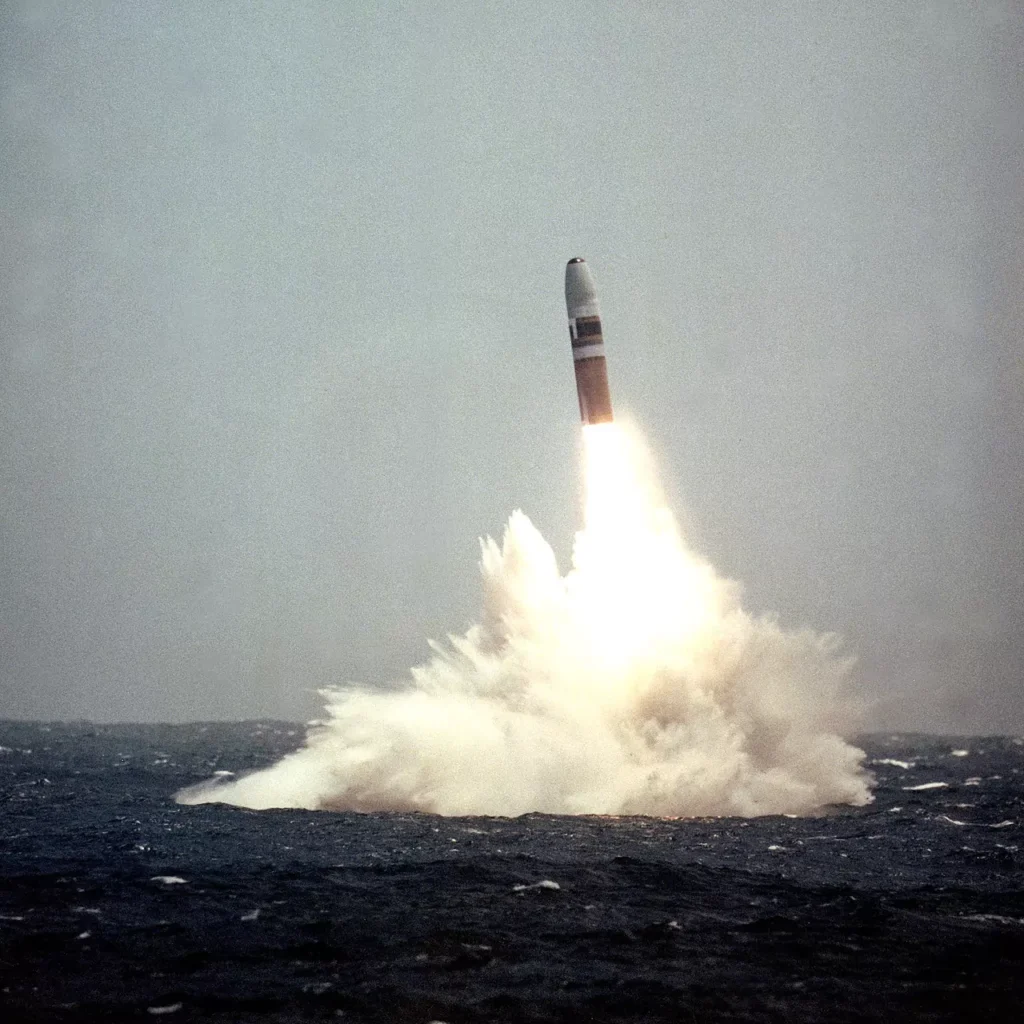
- The Navy’s fifth TRIDENT I (C4) Performance Evaluation Missile was successfully launched from the submerged submarine USS FRANCIS SCOTT KEY (SSBN 657).
30/31 JULY 1979
- The Navy’s sixth and seventh TRIDENT I (C4) Performance Evaluation Missiles were successfully launched from the submerged submarine USS FRANCIS SCOTT KEY (SSBN 657).
3 AUGUST 1979
- USS JAMES MADISON (SSBN 627) commenced overhaul and conversion to TRIDENT I capability at the Newport News Shipbuilding Drydock Company, Newport News, VA.
8 AUGUST 1979
- The POLARIS Missile Facility, Atlantic (POMFLANT), successfully completed the final phase of the Nuclear Weapons Acceptance Inspection (NWAI). This completes the POMFLANT to conduct operations with tactical TRIDENT I (C4) missiles. The first phase was completed on 10 July 1979.
28 AUGUST 1979
- The Blue Crew of USS FRANCIS SCOTT KEY (SSBN 657) successfully launched the first TRIDENT I (C4) production missile to be flight tested during the ship’s Demonstration and Shakedown Operation.
30/31 AUGUST 1979
- The Blue Crew of USS FRANCIS SCOTT KEY (SSBN 657) successfully completed a Nuclear Weapons Acceptance Inspection. As a result, the Blue Crew of SSBN 657 was certified to conduct operations with TRIDENT I (C4) missiles.
7 SEPTEMBER 1979
- USS MARIANO G. VALLEJO (SSBN 658) commenced Part I of the industrial phase of the TRIDENT I (C4) Backfit Program at the FBM Support Site in Charleston, SC. SSBN 658 was the second POSEIDON SSBN to be back-fitted pier side.
26 SEPTEMBER 1979
- The Gold Crew of USS FRANCIS SCOTT KEY (SSBN 657) successfully launched one TRIDENT I (C4) missile in support of the ship’s Demonstration and Shakedown Operation.
8 OCTOBER 1979
- USS FRANCIS SCOTT KEY (SSBN 657) commenced outload with TRIDENT I (C4) tactical missiles at the POLARIS Missile Facility, Atlantic.
15 OCTOBER 1979
- On behalf of the Secretary of the Navy, Admiral A.J. Whittle, Chief of Naval Material, presented the Navy Unit Commendation Award to the Strategic Systems Project Office. The Director, Rear Admiral R.H. Wertheim, USN, accepted on behalf of SSPO. The award was presented in recognition of exceptionally meritorious service by personnel of the Strategic Systems Project Office and participating in field activities in the prosecution of the TRIDENT I (C4) development program from October 1973 to October 1979.
16 OCTOBER 1979
- A consolidated FY 80 CPIF/CPFF production and processing contract (P&PC) was awarded to Lockheed Missiles and Space Company, Inc. The contract award was for approximately half a billion dollars and was the first contract of this type awarded by the Strategic Systems Project Office. The contract contained completion-type tasks for the production of TRIDENT I (C4) missiles as well as annual tasks, such as processing the C3/C4 missiles at the POLARIS Missile Facility, Atlantic, and A3/C4 missiles at the Strategic Weapons Facility, Pacific.
20 OCTOBER 1979
- USS FRANCIS SCOTT KEY (SSBN 657), the first POSEIDON SSBN configured with TRIDENT I (C4) missile capability, deployed for operational patrol.
5 NOVEMBER 1979
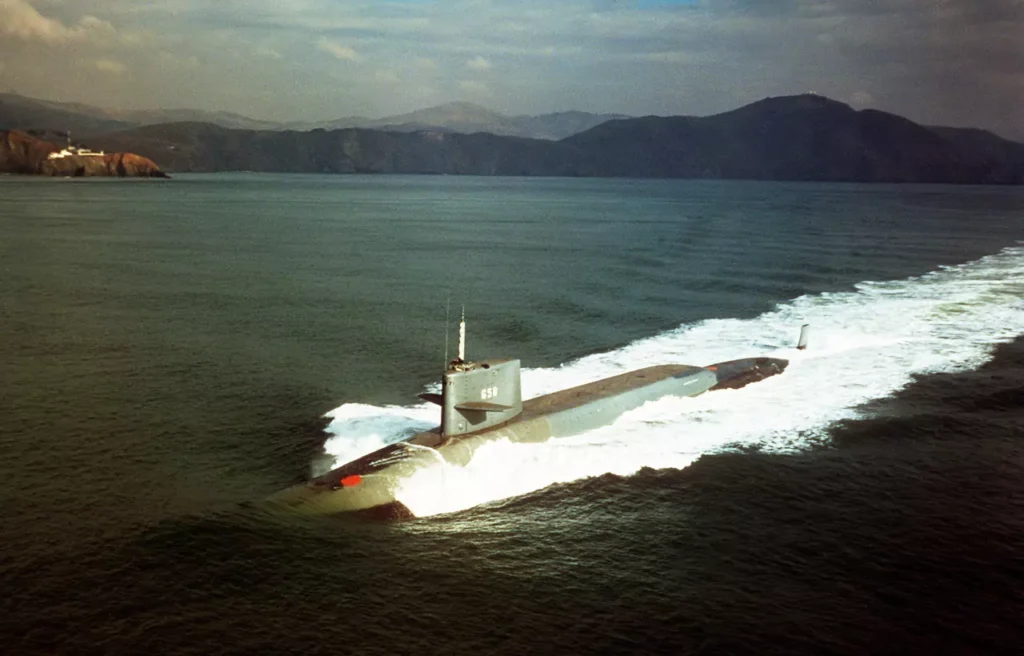
- USS MARIANO G. VALLEJO (SSBN 658) completed the industrial phase of conversion to the TRIDENT I missile capability.
9 NOVEMBER 1979
- FY 80 FPI multiple incentive contracts between the Strategic Systems Project Office and Hughes Aircraft Company, Kearfott Division, and General Electric Company, for TRIDENT I (C4) Mk 5 guidance systems were executed. These were the first contracts awarded using the equal quantity, performance, and competitive procurement concept. The performance evaluation features were structured to operate independently of the contract ceiling price.
12 NOVEMBER 1979
- USS BENJAMIN FRANKLIN (SSBN 640) commenced overhaul and conversion to TRIDENT I capability at the Portsmouth Naval Shipyard, Portsmouth, NH.
4 DECEMBER 1979
- USS HENRY L. STIMSON (SSBN 655) commenced Part I of the industrial phase of the TRIDENT I (C4) Pierisde Backfit Program at the FBM Support Site IV in Charleston, SC. SSBN 655 was the third POSEIDON SSBN to be backfitted per side.
10 DECEMBER 1979
- USS FRANCIS SCOTT KEY (SSBN 657) completed the first TRIDENT I operational patrol.
13 DECEMBER 1979
- The Gold Crew of USS MARIANO G. VALLEJO (SSBN 658) successfully launched the TRIDENT I (C4) missile in support of the ship’s Demonstration and Shakedown Operation.
1980s
1980
4 FEBRUARY 1980
- USS MARIANO G. VALLEJO (SSBN 658) deployed for operational patrol following pierside TRIDENT I conversion.
7 FEBRUARY 1980

- USS HENRY L. STIMSON (SSBN 655) completed pierside conversion to TRIDENT I capability.
28 FEBRUARY 1980
- The Blue Crew of USS FRANCIS SCOTT KEY (SSBN 657) successfully launched four TRIDENT I (C4) missiles in the first C4 Operational Test.
26 MARCH 1980
- The Gold Crew of USS HENRY L. STIMSON (SSBN 655) successfully launched one TRIDENT I (C4) missile in support of the ship’s Demonstration and Shakedown Operation.
2 APRIL 1980
- The Blue Crew of USS MARIANO G. VALLEJO (SSBN 658) successfully launched four TRIDENT I (C4) missiles during an Operational Test.
26 APRIL 1980
- The second TRIDENT submarine, USS MICHIGAN (SSBN 727), was launched at the Electric Boat Division. Mrs. Margaret Nedzi, wife of Congressman Nedzi, was the sponsor.
16 MAY 1980
- USS HENRY L. STIMSON (SSBN 655) deployed for operational patrol following pierside TRIDENT I conversion.
28 MAY 1980
- The Gold Crew of USS FRANCIS SCOTT KEY (SSBN 657) successfully launched four TRIDENT I (C4) missiles during an Operational Test.
30 MAY 1980

- USS DANIEL BOONE (SSBN 629) completed conversion to TRIDENT I capability.
27 JUNE 1980
- The Gold Crew of USS MARIANO G. VALLEJO (SSBN 658) successfully launched four TRIDENT I (C4) missiles during an Operational Test.
1 JULY 1980
- Strategic Weapons Facility, Pacific (SWFPAC) activation completed. POMFPAC SWFPAC.
21 JULY 1980
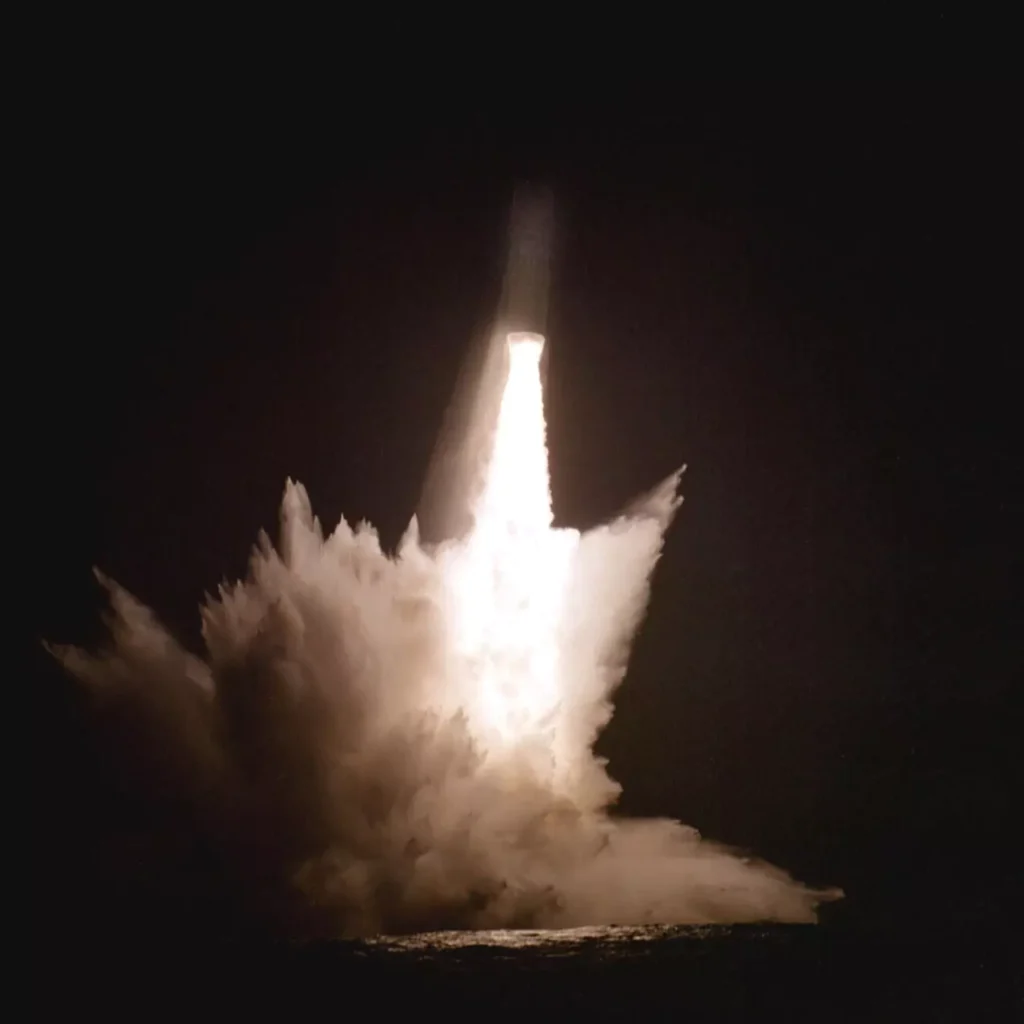
- The Gold Crew of USS DANIEL BOONE (SSBN 629) successfully launched one TRIDENT I (C4) missile in support of the ship’s Demonstration and Shakedown Operation.
28 JULY 1980
- Processing of TRIDENT I (C4) missiles commenced at the Strategic Weapons Facility, Pacific.
26 AUGUST 1980
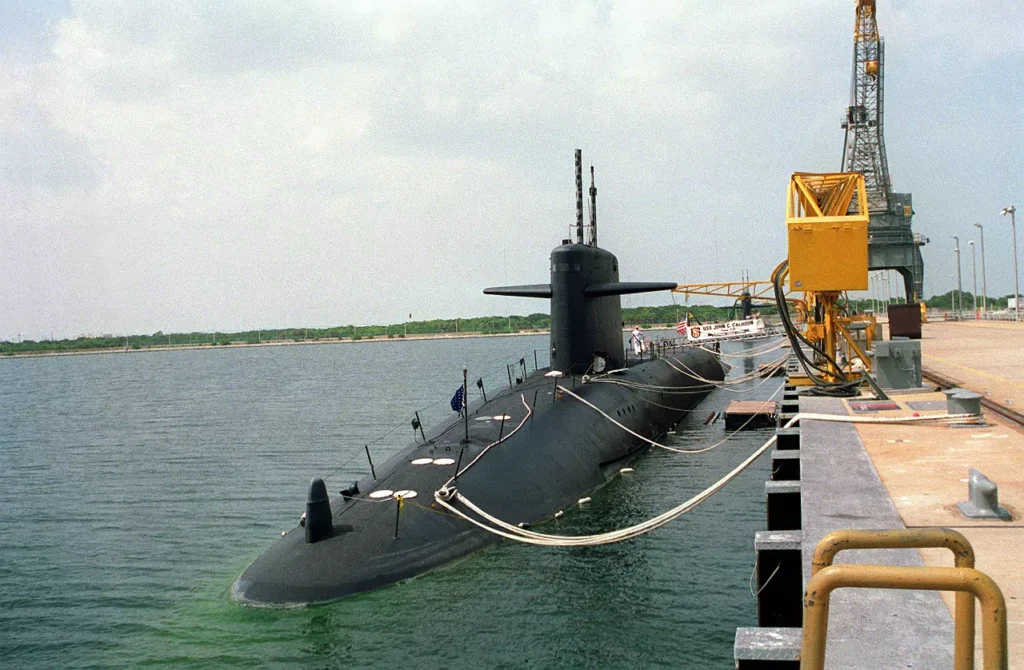
- USS JOHN C. CALHOUN (SSBN 630) completed conversion to TRIDENT I capability.
6 SEPTEMBER 1980
- USS DANIEL BOONE (SSBN 629) deployed for operational patrol following TRIDENT I conversion.
28 OCTOBER 1980
- The Blue Crew of USS JOHN C. CALHOUN (SSBN 630) successfully launched one TRIDENT I (C4) missile in support of the ship’s Demonstration and Shakedown Operation.
3 NOVEMBER 1980
- The first TRIDENT I (C4) missile to be assembled at the Strategic Weapons Facility, Pacific, was completed.
24 NOVEMBER 1980
- USS JOHN C. CALHOUN (SSBN 630) deployed for operational patrol following TRIDENT I conversion.
28 DECEMBER 1980

- USS SIMON BOLIVAR (SSBN 641) completed overhaul and conversion to TRIDENT I capability at Portsmouth Naval Shipyard, Portsmouth, NH. SSBN 641 was the first of six POSEIDON SSBNs to be backfitted during a regularly scheduled shipyard overhaul period
1981
1 APRIL 1981
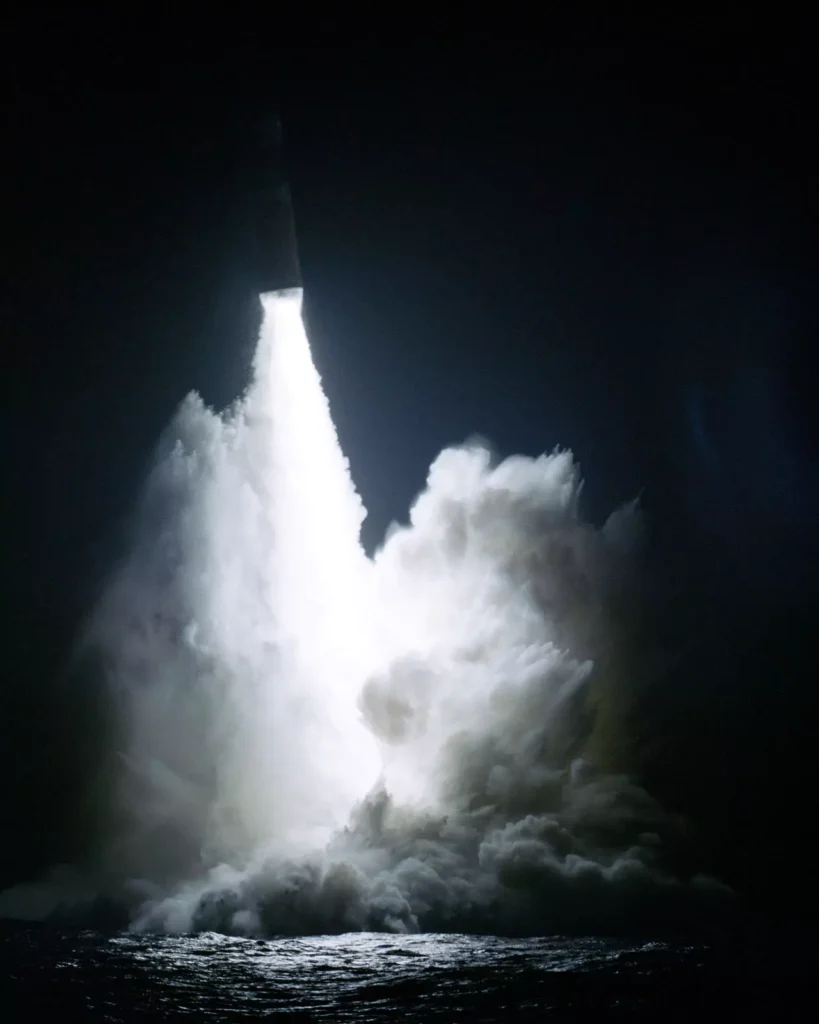
- The Gold Crew of USS SIMON BOLIVAR (SSBN 641) successfully launched one TRIDENT I (C4) missile in support of the ship’s Demonstration and Shakedown Operation. This was the first launch of a TRIDENT I (C4) missile produced at the Strategic Weapons Facility, Pacific (SWFPAC).
18 MAY 1981
- The Floating Drydock USS OAK RIDGE (ARDM 1) commenced overhaul at Atlantic Drydock Corporation, Ft. George Island, FL. The ship supports SSBN operations at Kings Bay, GA.
26 JUNE 1981
- USS SIMON BOLIVAR (SSBN 641) deployed for operational patrol following TRIDENT I conversion.
1 JULY 1981
- Submarine Base at Bangor, WA, was activated under the command of the Commander in Chief U.S. Pacific Fleet (CINCPACFLT). This was done to support the Navy’s TRIDENT fleet of ballistic missile submarines.
13 AUGUST 1981
- USS JOHN C. CALHOUN (SSBN 630) successfully launched four TRIDENT I (C4) missiles during an Operational Test.
28 AUGUST 1981
- During an Operational Test, the USS SIMON BOLIVAR (SSBN 641) successfully launched four TRIDENT I (C4) missiles.
18 SEPTEMBER 1981
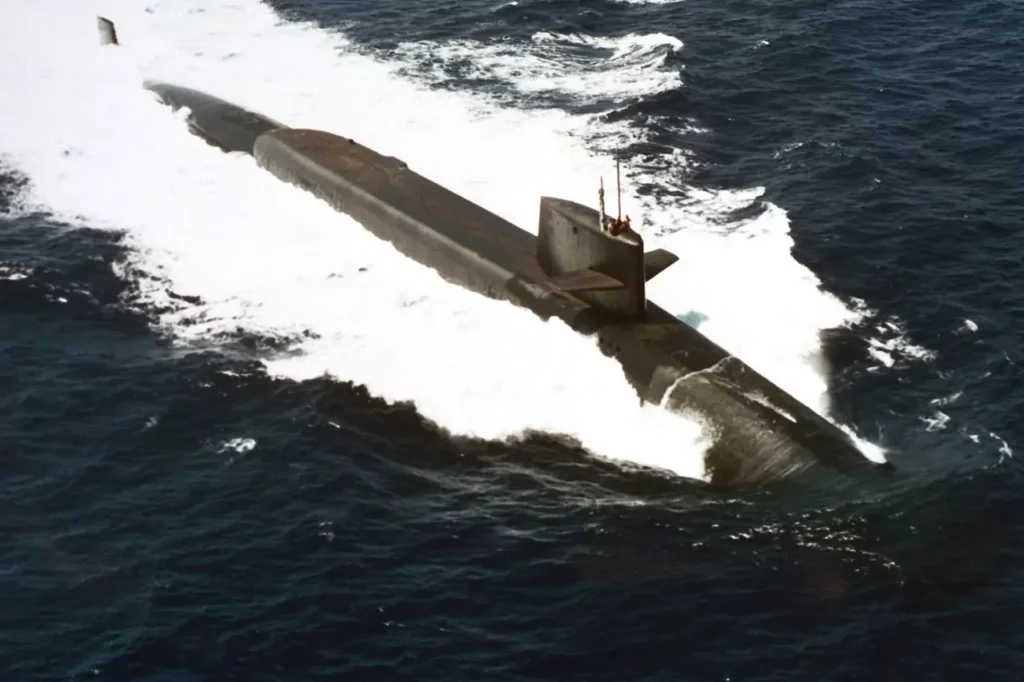
- USS BENJAMIN FRANKLIN (SSBN 640) completed overhaul and conversion to TRIDENT I capability at Portsmouth Naval Shipyard, Portsmouth, NH.
28 OCTOBER 1981
- USS OHIO (SSBN 726), the first TRIDENT Class Nuclear-Powered Fleet Ballistic Missile Submarine, completed construction.
11 NOVEMBER 1981

- USS OHIO (SSBN 726) was commissioned. Vice President George C. Bush was the principal speaker.
14 NOVEMBER 1981
- USS FLORIDA (SSBN 728), the third TRIDENT submarine, was launched at the Electric Boat Division of General Dynamics, Groton, CT. Mrs. Marcia Myers Carlucci, wife of the Deputy Secretary of Defense, was the sponsor.
15 NOVEMBER 1981
- USS BENJAMIN FRANKLIN (SSBN 640) successfully launched a TRIDENT I (C4) missile in support of the ship’s Demonstration and Shakedown Operation.
1982
17 JANUARY 1982

- The Blue Crew of USS OHIO (SSBN 726) successfully launched a TRIDENT I (C4) missile in support of the ship’s Demonstration and Shakedown Operation.
26 JANUARY 1982
- The Blue Crew of USS STONEWALL JACKSON (SSBN 634) successfully launched a TRIDENT I (C4) missile in support of the ship’s Demonstration and Shakedown Operation.
9 FEBRUARY 1982

- USS JAMES MADISON (SSBN 627) completed overhaul and conversion to TRIDENT I capability at Newport News Shipbuilding and Drydock Company, Newport News, VA.
18 FEBRUARY 1982
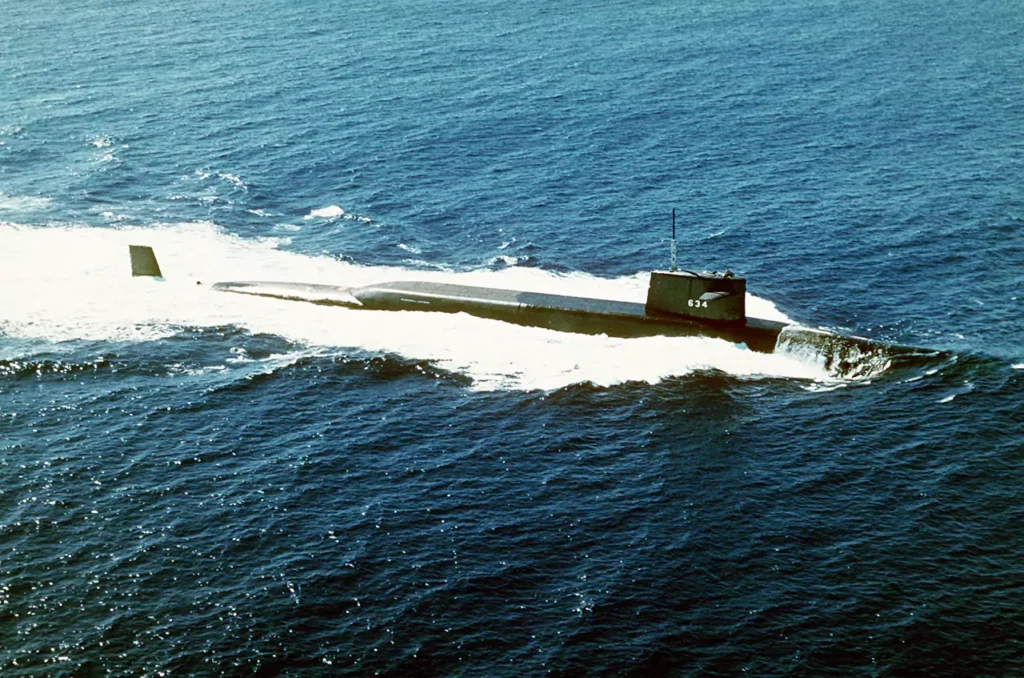
- USS STONEWALL JACKSON (SSBN 634) deployed for operational patrol following TRIDENT I pier side conversion. SSBN 634 was the last SSBN converted to TRIDENT I capability pier side.
5 MARCH 1982
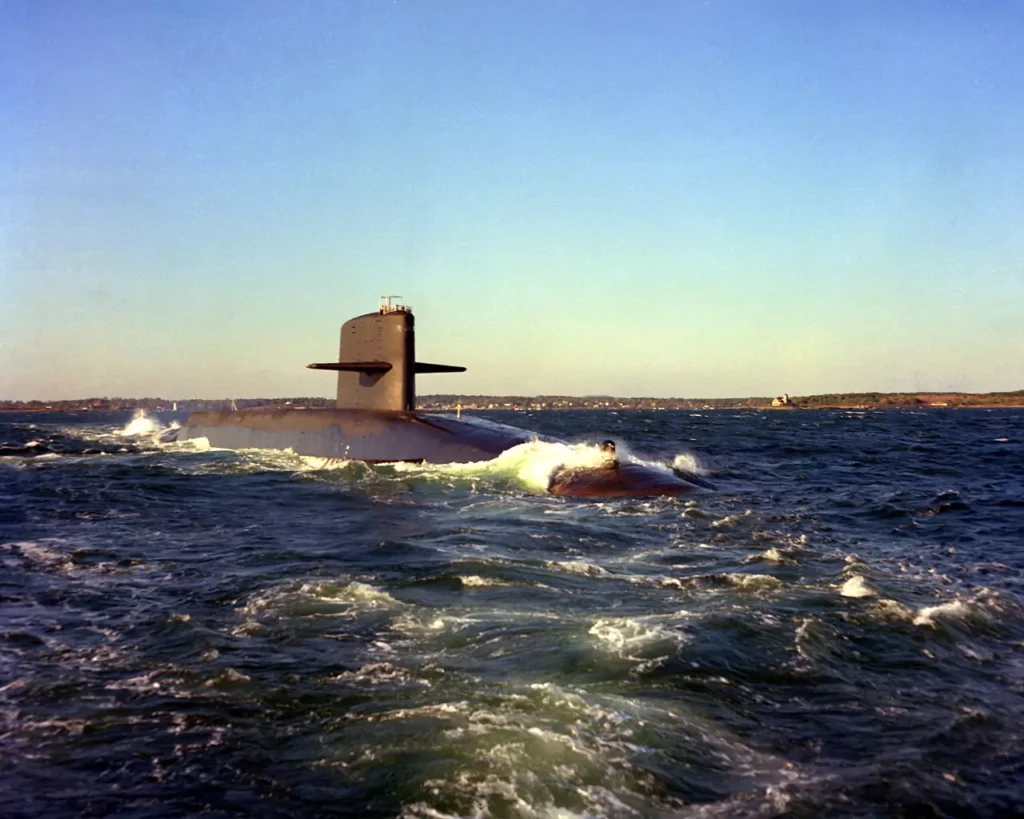
- USS GEORGE BANCROFT (SSBN 643) completed overhaul and conversion to TRIDENT I capability at Portsmouth Naval Shipyard, Portsmouth, NH.
13 MARCH 1982

- The Gold Crew of USS OHIO (SSBN 726) successfully launched a TRIDENT I (C4) missile in support of the ship’s Demonstration and Shakedown Operation.
17 MARCH 1982
- The Gold Crew of USS MARIANO G. VALLEJO (SSBN 658) successfully launched four TRIDENT I (C4) missiles during an Operational Test.
1 APRIL 1982
- The U.S. Naval Submarine Support Base (NAVSUBSUPBASE), Kings Bay, was renamed the U.S. Naval Submarine Base (SUBASE), Kings Bay, GA.
14 APRIL 1982
- USS BENJAMIN FRANKLIN (SSBN 640) deployed for operational patrol following TRIDENT I conversion.
20 APRIL 1982
- USS POINT LOMA (T-AGDS 2) completed overhaul at Mare Island Naval Shipyard, Vallejo, CA. The USS POINT LOMA was overhauled for use as a Launch Area Support Ship (LASS) in support of TRIDENT I (C4) missile testing in the Pacific.
24 APRIL 1982
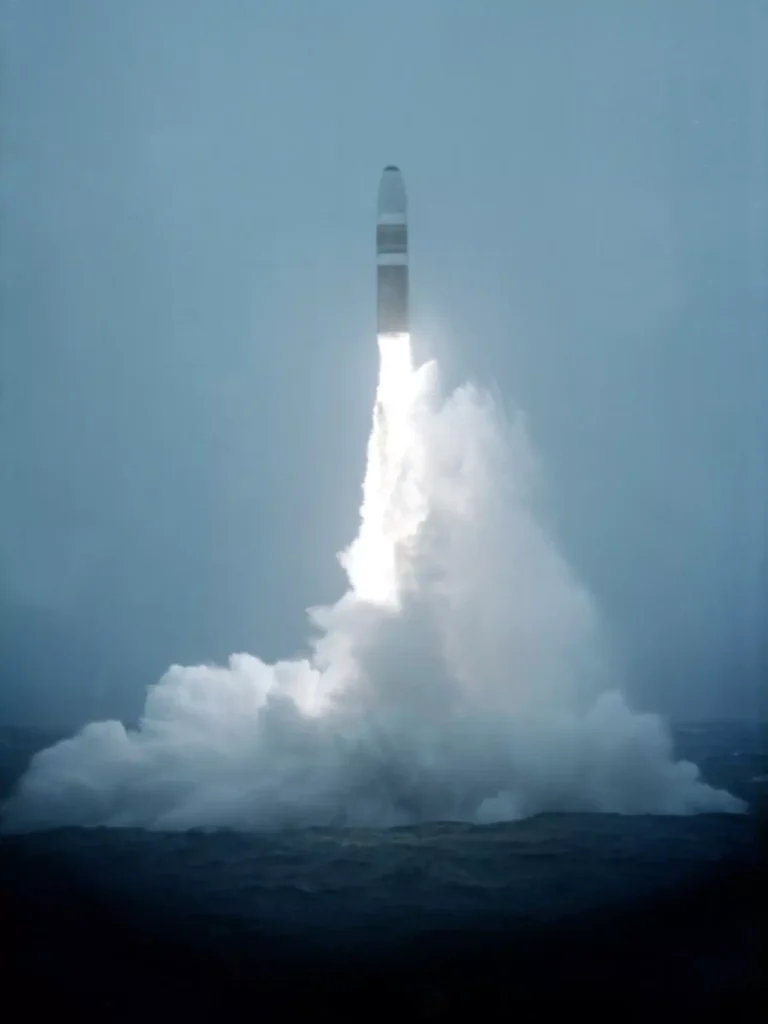
- The Blue Crew of the USS GEORGE BANCROFT (SSBN 643) successfully launched a TRIDENT I (C4) missile in support of the ship’s Demonstration and Shakedown Operation.
1 JUNE 1982
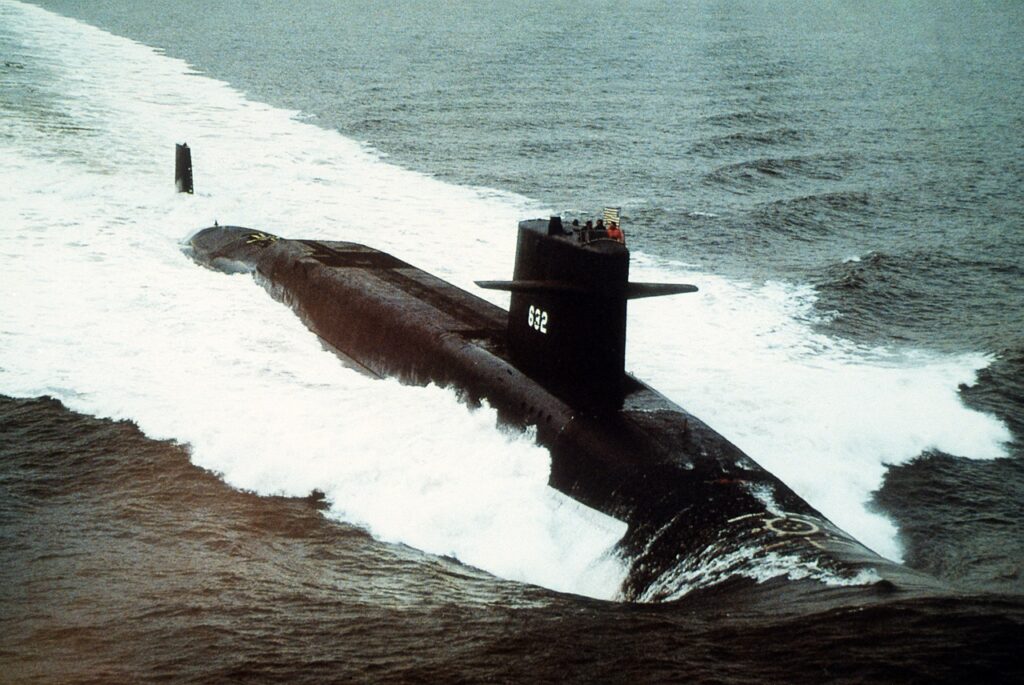
- USS VON STEUBEN (SSBN 632) completed overhaul and conversion to TRIDENT I capability at Newport News Shipbuilding and Drydock Company, Newport News, VA.
5 JUNE 1982
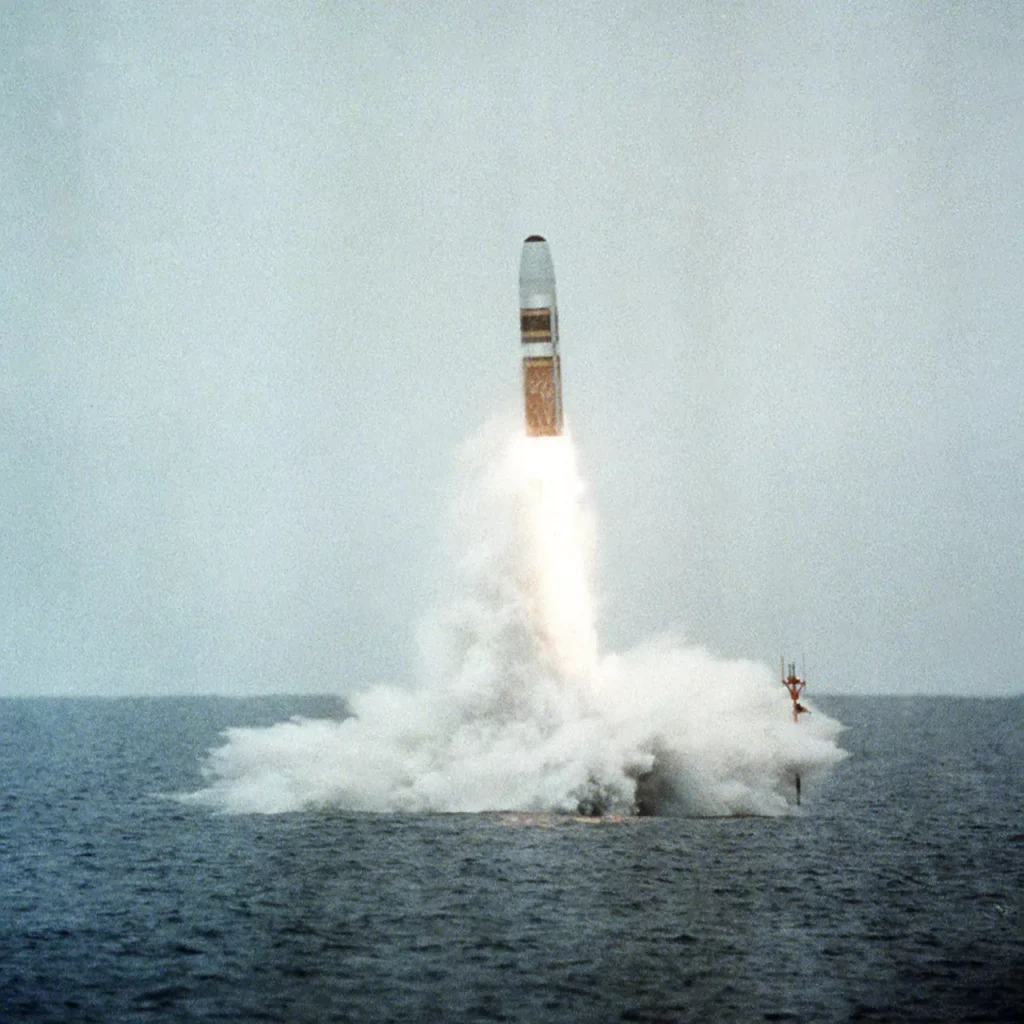
- The Gold Crew of USS JAMES MADISON (SSBN 627) successfully launched a TRIDENT I (C4) missile in support of the ship’s Demonstration and Shakedown Operation.
20 JULY 1982
- USS GEORGE BANCROFT (SSBN 643) deployed for operational patrol following TRIDENT I conversion.
25 AUGUST 1982
- The arrival of USS OHIO (SSBN 726) at Bangor, WA, culminated the integration of the principal TRIDENT elements—the ship, missile, and dedicated support base—into an operational system.
28 AUGUST 1982
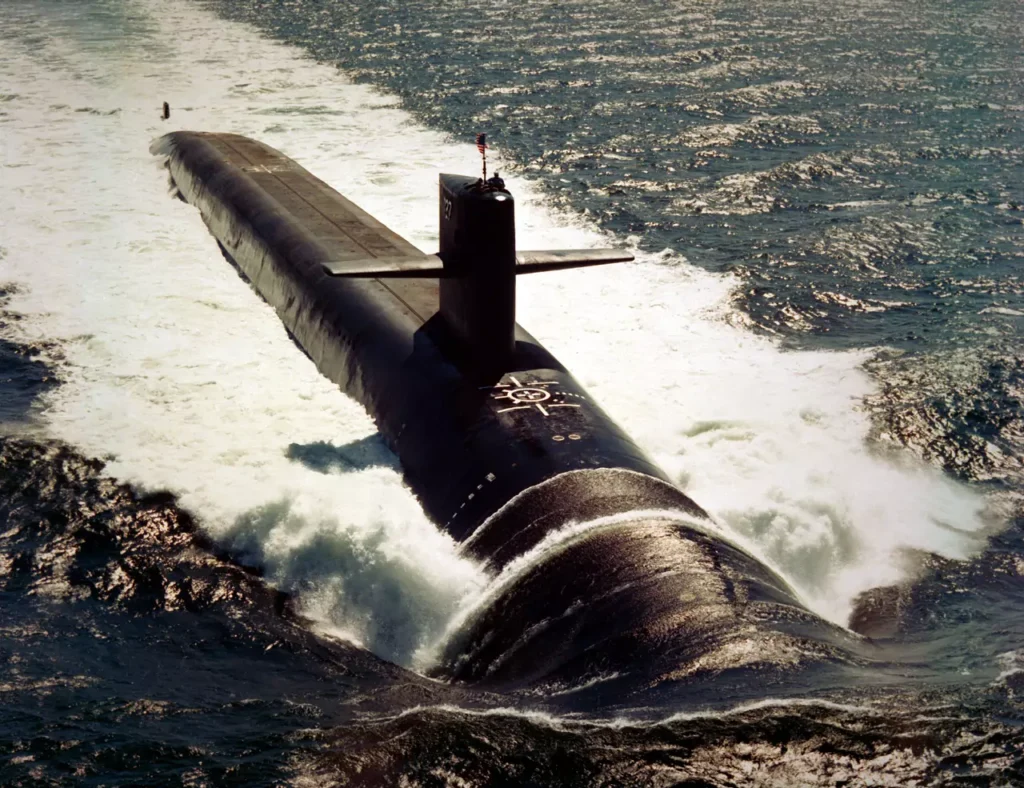
- USS MICHIGAN (SSBN 727), the second TRIDENT submarine, was delivered. USS MICHIGAN was constructed at the Electric Boat Division of General Dynamics, Groton, CT. MICHIGAN’s keel was laid on 4 April 1977, sea trials started on 21 May 1982, and she was commissioned on 11 September 1982. USS MICHIGAN was home-ported at Bangor, WA.
6 SEPTEMBER 1982
- Initial Operational Capability (IOC) of the TRIDENT SSBN force and TRIDENT I (C4) weapon system was achieved when USS OHIO (SSBN 726) completed pre-deployment at Strategic Weapons Facility Pacific, Bremerton, WA, and deployed in the Pacific. USS OHIO began the first TRIDENT patrol on 1 October 1982.
6 NOVEMBER 1982
- USS GEORGIA (SSBN 729), the fourth TRIDENT submarine, was launched at the Electric Boat Division of General Dynamics, Groton, CT.
4 NOVEMBER 1982
- The Gold Crew of USS VON STEUBEN (SSBN 632) successfully launched a TRIDENT I (C4) missile in support of the ship’s Demonstration and Shakedown Operation.
21 NOVEMBER 1982

- The Blue Crew of USS MICHIGAN (SSBN 727), the second TRIDENT submarine, successfully launched a TRIDENT I (C4) missile in support of the ship’s Demonstration and Shakedown Operation.
10 DECEMBER 1982
- USS OHIO (SSBN 726) returned from the first TRIDENT operational patrol.
10 DECEMBER 1982

- USS CASIMIR PULASKI (SSBN 633) completed overhaul and conversion to TRIDENT I capability at Newport News Shipbuilding and Drydock Company, Newport News, VA.
31 DECEMBER 1982
- By the end of CY 82, a total of 2119 POLARIS (A3)/POSEIDON (C3)/TRIDENT I (C4) Fleet Ballistic Missile strategic deterrent patrols were successfully completed.
1983
3 JANUARY 1983
- USS MARIANO G. VALLEJO (SSBN 658) commenced a refueling overhaul at the Charleston Naval Shipyard, Charleston, SC.
1 FEBRUARY 1983
- USS FRANCIS SCOTT KEY (SSBN 657) commenced a refueling overhaul at Newport News Shipbuilding and Drydock Company, Newport News, VA.
7 FEBRUARY 1983
- The Gold Crew of USS BENJAMIN FRANKLIN (SSBN 640) successfully launched two TRIDENT I (C4) missiles during a Follow-on Operational Test.
21 MARCH 1983
- The Director, Strategic Systems Projects, proposed that Strategic Weapons Facility, Atlantic (SWFLANT) be established as a shore facility, in an active development status, effective 1 May 1983.
19 APRIL 1983
- The Gold Crew of USS CASIMIR PULASKI (SSBN 633) successfully launched a TRIDENT I (C4) missile in support of the ship’s Demonstration and Shakedown Operation.
17 MAY 1983
- USS FLORIDA (SSBN 728), the third TRIDENT submarine, was delivered to the Navy by the Shipbuilder, Electric Boat Division of General Dynamics, Groton, CT.
3 JUNE 1983
- USS CASIMIR PULASKI (SSBN 633) deployed for operational patrol following TRIDENT I conversion.
3 JUNE 1983
- USS MICHIGAN (SSBN 727) completed her first strategic loadout at Strategic Weapons
18 JUNE 1983
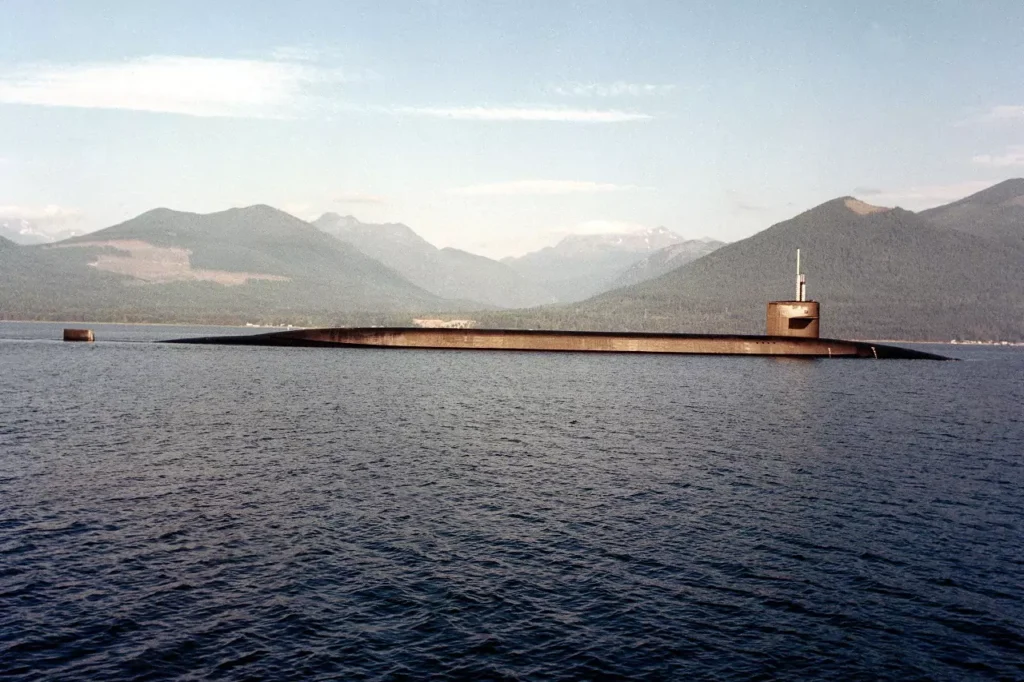
- USS FLORIDA (SSBN 728), the third TRIDENT submarine, was commissioned during ceremonies at the Electric Boat Division of General Dynamics, Groton, CT. The principal speaker for the event was Senator Paula Hawkins (R-FL).
30 JUNE 1983
- The responsibility for acquiring the Naval Submarine Base, Kings Bay, was transferred to SSPO because of the disestablishment of PM-2.
5 AUGUST 1983
- The Blue Crew of USS SIMON BOLIVAR (SSBN 641) successfully launched two TRIDENT I (C4) missiles during a Follow-on Operational Test.
21 AUGUST 1983

- The Blue Crew of USS FLORIDA (SSBN 728) successfully launched a TRIDENT I (C4) missile in support of the ship’s Demonstration and Shakedown Operation.
6 SEPTEMBER 1983
- The Gold Crew of USS OHIO (SSBN 726) successfully launched four TRIDENT I (C4) missiles in a Follow-on Operational Test. This was the first TRIDENT I (C4) flight test conducted in the Pacific. The test used the new Pacific Flight Test Support System funded by the Strategic Systems Project Office and operated by the Navy’s Pacific Missile Test Center.
3 OCTOBER 1983
- The Gold Crew of USS FLORIDA (SSBN 728) successfully launched a TRIDENT I (C4) missile in support of the ship’s Demonstration and Shakedown Operation.
15 OCTOBER 1983
- USS HENRY M. JACKSON (SSBN 730), the fifth TRIDENT submarine, was launched during ceremonies at the Electric Boat Division of General Dynamics, Groton, CT. The submarine, originally called RHODE ISLAND, was renamed HENRY M. JACKSON by Presidential Proclamation, in honor of the late senator from the State of Washington who was an ardent supporter of the TRIDENT program.
7 NOVEMBER 1983
- The Blue Crew of USS VON STEUBEN (SSBN 632) successfully launched two TRIDENT I (C4) missiles in a Follow-on Operational Test.
1984
16 JANUARY 1984
- USS CANOPUS (AS 34) commenced overhaul at Charleston Naval Shipyard, Charleston, SC. This overhaul was to include reconfiguration to dual C3/C4 capability.
17 JANUARY 1984
- USS GEORGIA (SSBN 729) was delivered to the Navy 6 weeks ahead of schedule by the shipbuilder, Electric Boat Division of General Dynamics, Groton, CT.
11 FEBRUARY 1984
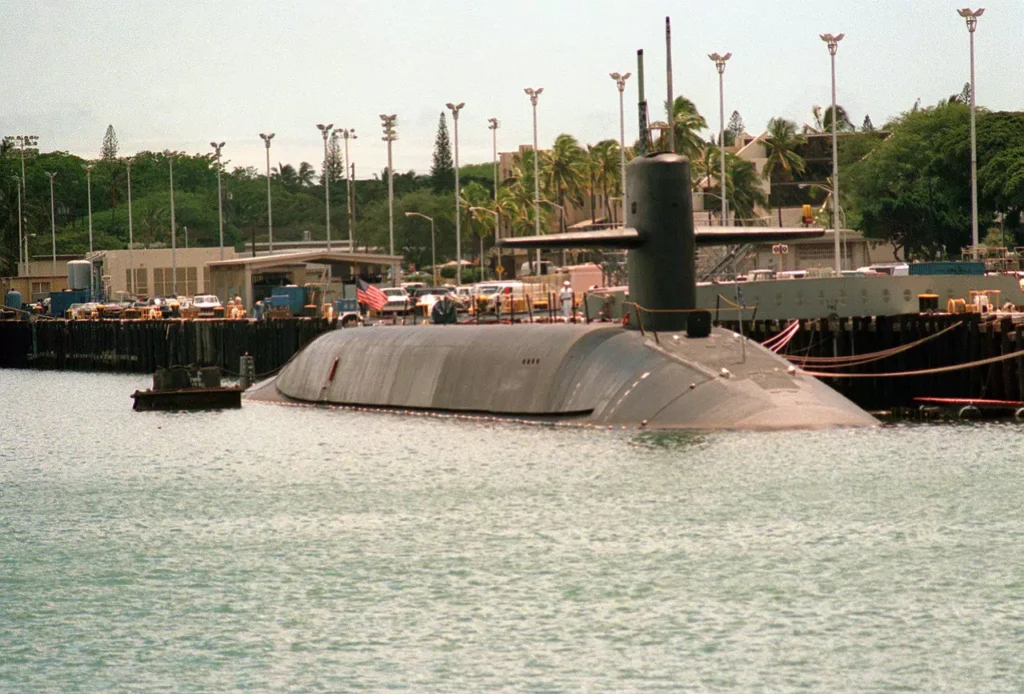
- USS GEORGIA (SSBN 729), the fourth TRIDENT submarine, was commissioned during ceremonies held at the Naval Underwater Systems Center, New London, CT. Mrs. Joan D. Watkins, wife of the Chief of Naval Operations, was the sponsor.
7 APRIL 1984
- The Blue Crew of the USS GEORGIA (SSBN 729) successfully launched a TRIDENT I (C4) missile in support of its Demonstration and Shakedown Operation.
12 APRIL 1984
- USS FLORIDA (SSBN 728) completed her first strategic loadout at Strategic Weapons Facility, Pacific, Bremerton, WA, and deployed. The first patrol began on 11 May 1984.
19 MAY 1984
- USS ALABAMA (SSBN 731), the sixth TRIDENT submarine, was launched at Electric Boat Division, Groton, CT. Mrs. Barbara Dickinson, wife of Congressman William L. Dickinson (R-AL), was the sponsor.
3 JUNE 1984
- USS OHIO (SSBN 726) successfully launched four TRIDENT I (C4) missiles during a Follow-on Operational Test.
2 JULY 1984
- USS MICHIGAN (SSBN 727) successfully launched four TRIDENT I (C4) missiles during an Operational Test.
24 AUGUST 1984
- USS JOHN C. CALHOUN (SSBN 630) successfully launched two TRIDENT I (C4) missiles during an Operational Test.
4 SEPTEMBER 1984
- Groundbreaking ceremonies were held for the TRIDENT Training Facility at Naval Submarine Base, Kings Bay, GA. Construction of the facility was scheduled to be completed in December 1986.
11 SEPTEMBER 1984
- USS HENRY M. JACKSON (SSBN 730), the fifth TRIDENT submarine, was delivered to the Navy by the shipbuilder, Electric Boat Division of General Dynamics, Groton, CT.
12 SEPTEMBER 1984
- USS FLORIDA (SSBN 728) successfully launched four TRIDENT I (C4) missiles during an Operational Test.
1 OCTOBER 1984
- USS JOHN C. CALHOUN (SSBN 630) commenced a refueling overhaul at Charleston Naval Shipyard, Charleston, SC.
6 OCTOBER 1984

- USS HENRY M. JACKSON (SSBN 730) was commissioned during ceremonies held at the Naval Underwater Systems Center, New London, CT. It was the fifth OHIO Class TRIDENT submarine and the first TRIDENT Class submarine to be named after a person, the ship’s namesake was Senator Henry M. Jackson, the late senior Senator from the State of Washington.
9 OCTOBER 1984
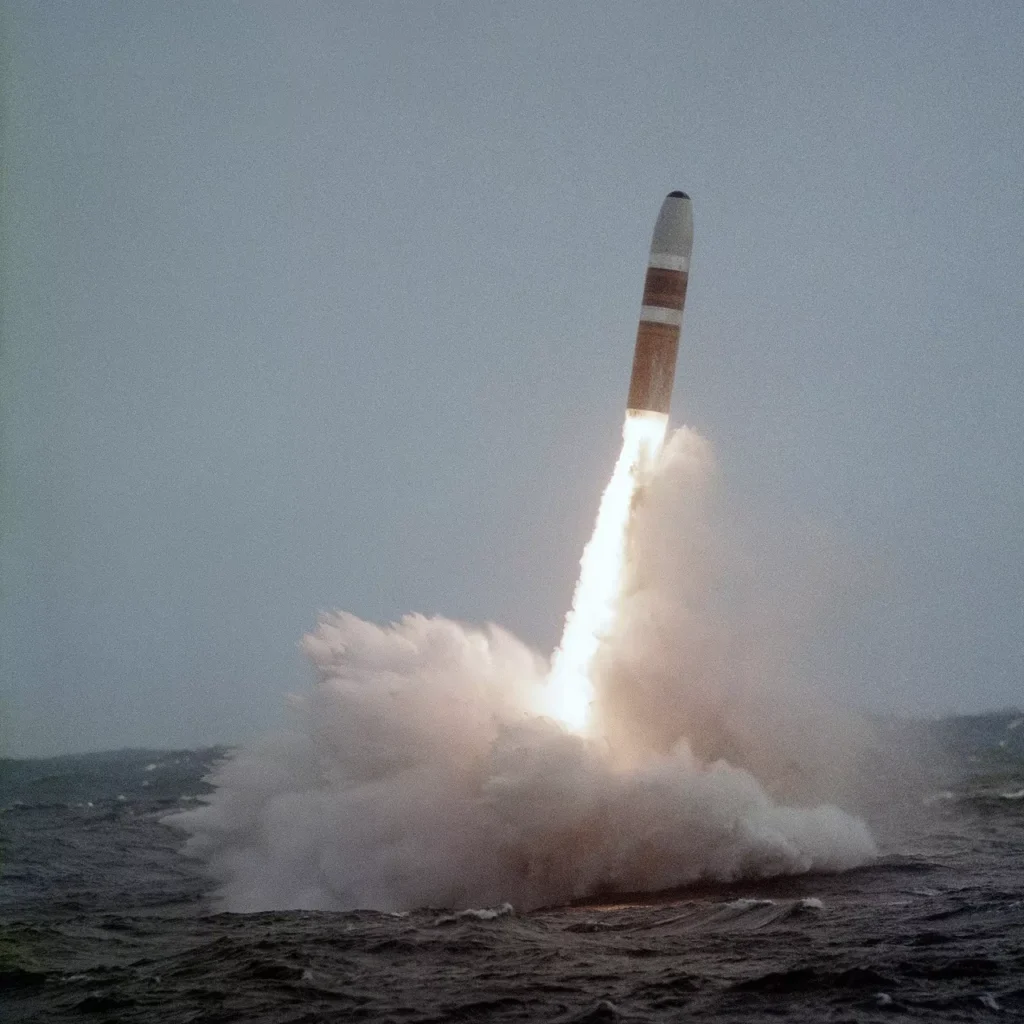
- The Gold Crew of USS MARIANO G. VALLEJO (SSBN 658) successfully launched a TRIDENT I (C4) missile in support of its Demonstration and Shakedown Operation.
3 DECEMBER 1984
- USS GEORGIA (SSBN 729) completed her first strategic loadout at Strategic Weapons Facility, Pacific, Bremerton, WA, and deployed. The first patrol began on 26 January 1985.
4 DECEMBER 1984
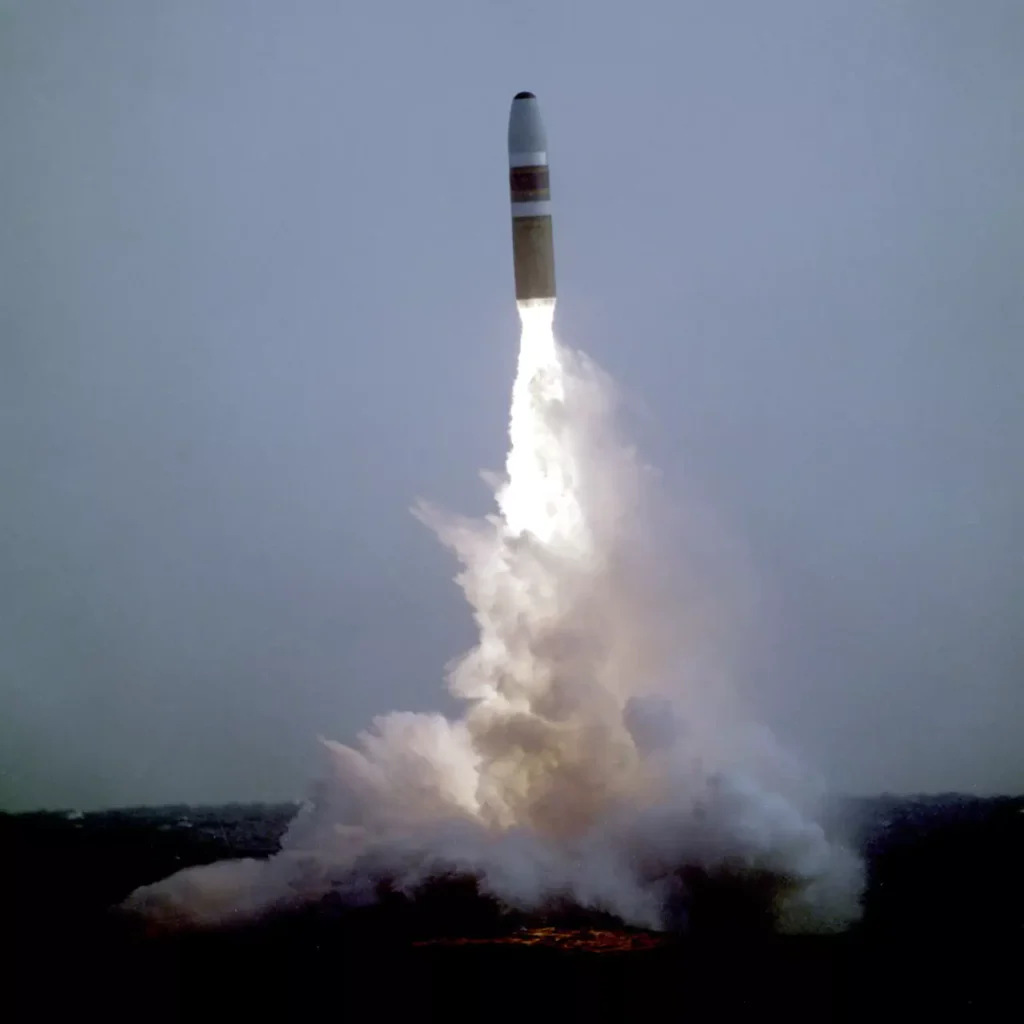
- The Blue Crew of USS HENRY M. JACKSON (SSBN 730) successfully launched a TRIDENT I (C4) missile in support of the ship’s Demonstration and Shakedown Operation.
15 DECEMBER 1984
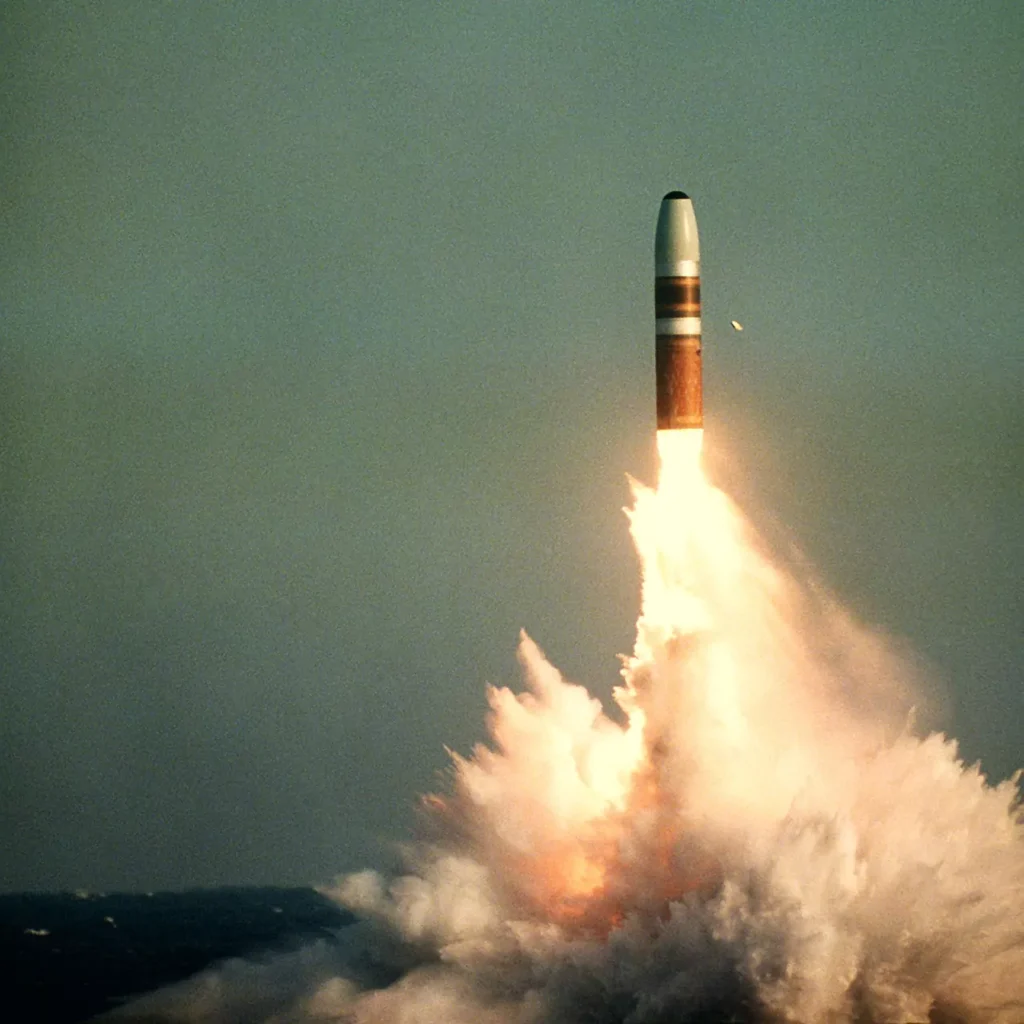
- The Gold Crew of USS HENRY L. STIMSON (SSBN 655) successfully launched a TRIDENT I (C4) missile in support of the ship’s Demonstration and Shakedown Operation.
1985
1 JANUARY 1985
- SWFLANT groundbreaking began.
7 JANUARY 1985
- USS DANIEL BOONE (SSBN 629) commenced a refueling overhaul at Newport News Shipbuilding and Drydock Company, Newport News, VA.
12 JANUARY 1985
- USS ALASKA (SSBN 732), the seventh TRIDENT submarine, was launched at Electric Boat Division during ceremonies at Groton, CT. Senator Ted of General Dynamics was the principal speaker, and Mrs. Stevens (R-AK) was the sponsor.
22 APRIL 1985
- USS MICHIGAN (SSBN 727) successfully launched four TRIDENT I (C4) missiles during a Follow-on Operational Test.
23 APRIL 1985
- USS ALABAMA (SSBN 731), the sixth TRIDENT submarine, was delivered to the Navy by the shipbuilder, Electric Boat Division of General Dynamics, Groton, CT.
25 MAY 1985

- USS ALABAMA (SSBN 731), the sixth TRIDENT submarine, was commissioned.
26 MAY 1985
- USS GEORGIA (SSBN 729) successfully launched four TRIDENT I (C4) missiles during a Follow-on Operational Test.
17 JUNE 1985
- USS CASIMIR PULASKI (SSBN 633) successfully launched four TRIDENT I (C4) missiles during a Follow-on Operational Test.
6 JULY 1985
- USS ALABAMA (SSBN 731) successfully launched a TRIDENT I (C4) missile in support of the ship’s Demonstration and Shakedown Operation.
16 AUGUST 1985
- USS HENRY M. JACKSON (SSBN 730) completed her first strategic loadout at Strategic Weapons Facility, Pacific, Bremerton, WA, and deployed. The first patrol began on 26 September 1985.
25 AUGUST 1985
- USS FRANCIS SCOTT KEY (SSBN 657) completed a refueling overhaul at Newport News Shipbuilding and Drydock Company, Newport News, VA.
12-13 SEPTEMBER 1985
- USS GEORGIA (SSBN 729) successfully launched two TRIDENT I (C4) missiles during a Follow-on Operational Test.
14 SEPTEMBER 1985
- USS NEVADA (SSBN 733), the eighth TRIDENT submarine, was launched during ceremonies at the Electric Boat Division of General Dynamics, Groton, CT. Mrs. Carol Laxalt, wife of Senator Paul Laxalt (R-NV), was the sponsor.
26 NOVEMBER 1985
- USS ALASKA (SSBN 732), the seventh TRIDENT submarine, was delivered to the Navy by the shipbuilder, Electric Boat Division of General Dynamics, Groton, CT.
DECEMBER 1985
- USS FRANCIS SCOTT KEY (SSBN 657) successfully launched a TRIDENT (C4) missile in support of the ship’s Demonstration and Shakedown Operation.
1986
January 1986

- The Navy received the last TRIDENT (C4) missile
25 JANUARY 1986
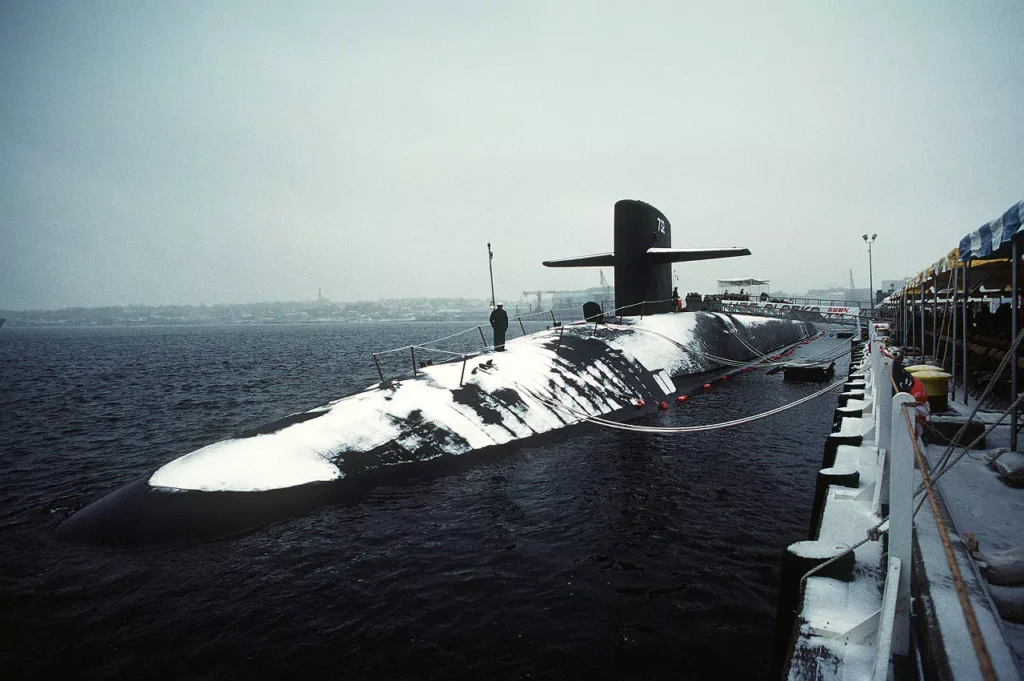
- USS ALASKA (SSBN 732), the seventh TRIDENT Fleet Ballistic Missile submarine, was commissioned during ceremonies at Naval Underwater Systems Center, New London, CT.
18 FEBRUARY 1986
- USS FRANCIS SCOTT KEY (SSBN 657) deployed for operational patrol following refueling overhaul.
21 FEBRUARY 1986
- USS ALASKA (SSBN 732) Blue Crew successfully launched a TRIDENT I (C4) missile in support of the ship’s Demonstration and Shakedown Operation.
28 MARCH 1986
- USS ALABAMA (SSBN 731) completed her first strategic loadout at Strategic Weapons Facility, Pacific, Bremerton, WA, and deployed. The first patrol began on 10 May 1986.
28 APRIL 1986
- USS OHIO (SSBN 726) Gold Crew successfully launched two TRIDENT I (C4) missiles during a Follow-on Operational Test.
23 JULY 1986
- USS JOHN C. CALHOUN (SSBN 630) completed a refueling overhaul at Charleston Naval Shipyard, Charleston, SC.
25 JULY 1986
- USS BENJAMIN FRANKLIN (SSBN 640) commenced a refueling overhaul at Charleston Naval Shipyard, Charleston, SC. She was the last FY 86 overhaul and the last TRIDENT I Backfit boat scheduled to enter overhaul.
28 JULY 1986
- USS HENRY L. STIMSON (SSBN 655) successfully launched two TRIDENT I (C4) missiles during a Follow-on Operational Test.
28 JULY 1986
- USS ALABAMA (SSBN 731) completed her first operational patrol.
7 AUGUST 1986
- USS NEVADA (SSBN 733), the last TRIDENT I submarine to be constructed, was delivered to the Navy by the shipbuilder.
13 AUGUST 1986
- USS FLORIDA (SSBN 728) Blue Crew successfully launched two TRIDENT I (C4) missiles during a Follow-on Operational Test.
16 AUGUST 1986

- USS NEVADA (SSBN 733), the eighth TRIDENT Fleet Ballistic Missile submarine, was commissioned during ceremonies at the Electric Boat Division of General Dynamics, Groton, CT.
31 AUGUST 1986
- USS JOHN C. CALHOUN (SSBN 630) Blue Crew successfully launched a TRIDENT I (C4) missile in support of the ship’s Demonstration and Shakedown Operation.
12 SEPTEMBER 1986
- USS MICHIGAN (SSBN 727) successfully launched two TRIDENT I (C4) missiles during a Follow-on Operational Test.
17 SEPTEMBER 1986
- USS VON STEUBEN (SSBN 632) successfully launched two TRIDENT I (C4) missiles during a Follow-on Operational Test.
30 SEPTEMBER 1986
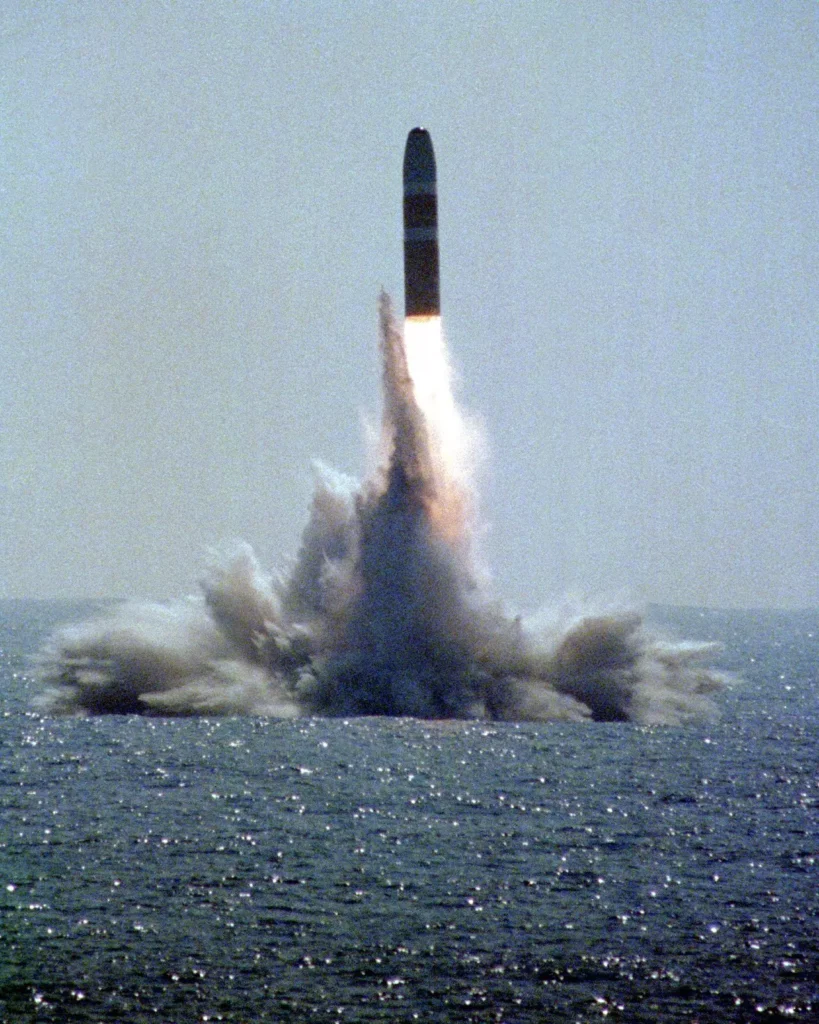
- USS NEVADA (SSBN 733) Blue Crew successfully launched a TRIDENT I (C4) missile in support of the ship’s Demonstration and Shakedown Operation.
17 OCTOBER 1986
- Missile motor FP-0776 completed manufacture and was the last production evaluation test motor in the C4 program.
23 OCTOBER 1986
- USS ALASKA (SSBN 732) completed her first strategic loadout at Strategic Weapons Facility, Pacific, Bremerton, WA, and deployed. The first patrol began on 7 December 1986.
22 NOVEMBER 1986
- USS OHIO (SSBN 726) Gold Crew completed the 50th TRIDENT I patrol.
28 NOVEMBER 1986
- USS JOHN C. CALHOUN (SSBN 630) deployed for operational patrol following refueling overhaul.
30 DECEMBER 1986
- The DIRSSP established a working group to develop a transition plan for the transfer of the Kings Bay Naval Submarine Base and the TRIDENT Refit Facility to the Commander in Chief, Atlantic Fleet, and the Kings Bay TRIDENT Training Facility to the Chief of Naval Education and Training. The working group was tasked to identify the timing for the transfer, and detail the functions, funding, and manpower to be transferred. A completed transition plan was scheduled for 31 March 1987.
1987
30 JANUARY 1987
- A $22.9 million contract was awarded to Brinderson Corporation of Irvine, CA, to complete the construction of the TRIDENT Training Facility at the Naval Submarine Base, Kings Bay, GA.
19 FEBRUARY 1987
- USS NEVADA (SSBN 733) commenced a Post Shakedown Availability at Newport News Shipbuilding, Newport News, VA.
22 FEBRUARY 1987
USS ALASKA (SSBN 732) completed her first operational patrol.
2 APRIL 1987
- The arrival of USS MARIANO G. VALLEJO (SSBN 658) at Naval Submarine Base, Kings Bay, GA, marked the completion of the 2500th FBM deterrent patrol.
8 APRIL 1987
- USS NEVADA (SSBN 733) completed a Post Shakedown Availability at Newport News Shipbuilding, Newport News, VA.
11 AUGUST 1987
- USS NEVADA (SSBN 733) completed her first strategic loadout at Strategic Weapons Facility, Pacific, Bremerton, WA, and deployed. The first patrol began on 28 September 1987. This completed the employment of the TRIDENT SSBN force in the Pacific.
14 AUGUST 1987
- USS ALASKA (SSBN 732) successfully launched four TRIDENT I (C4) missiles in support of the 27th TRIDENT Follow-on Operational Test.
18 AUGUST 1987
- The DIRSSP was commended by Rear Commander, Submarine Force Pacific, on Admiral J. Guy Reynolds, USN, and outstanding support, superb coordination, and outstanding support, superb coordination, and professionalism in the successful launch of four TRIDENT I (C4) missiles from SSBN 732 during FOT-27. The commendation stated that the results “continue the flawless record of the TRIDENT I (C4) Strategic Weapon System in the Pacific.”
23 AUGUST 1987
- USS DANIEL BOONE (SSBN 629) Blue Crew successfully launched a TRIDENT I (C4) missile in support of the ship’s Demonstration and Shakedown Operation.
29 AUGUST 1987
- USS JOHN C. CALHOUN (SSBN 630) successfully ripple launched four TRIDENT I (C4) missiles during the 28th TRIDENT Follow-on Operational Test.
20 NOVEMBER 1987
- USS SIMON BOLIVAR (SSBN 641) completed a refueling overhaul at Portsmouth Naval Shipyard, Portsmouth, NH.
15 DECEMBER 1987
- USS STONEWALL JACKSON (SSBN 634) completed a refueling overhaul at Charleston Naval Shipyard, Charleston, SC.
1988
6 FEBRUARY 1988
- USS SIMON BOLIVAR (SSBN 641) Blue Crew successfully launched a TRIDENT I (C4) missile in support of the ship’s Demonstration and Shakedown Operation.
24 FEBRUARY 1988
- USS NEVADA (SSBN 733) successfully launched two TRIDENT I (C4) missiles during the 29th TRIDENT I (C4) Follow-on Operational Test.
27 FEBRUARY 1988
- USS STONEWALL JACKSON (SSBN 634) Blue Crew successfully launched a TRIDENT I (C4) missile in support of the ship’s Demonstration and Shakedown Operation.
29 MARCH 1988
- USS SIMON BOLIVAR (SSBN 641) completed a strategic loadout at POMFLANT. She was the ninth TRIDENT I Backfit SSBN at sea, completing the squadron of ships at Kings Bay.
15 APRIL 1988
- USS MARIANO G. VALLEJO (SSBN 658) successfully launched four missiles in support of the 30th TRIDENT I (C4) Follow-on Operational Test.
24 APRIL 1988
- USS STONEWALL JACKSON (SSBN 634) completed a strategic loadout at POMFLANT. She would commence patrol in August and would be the first of three TRIDENT I Backfit SSBNs to operate out of Charleston.
14-16 MAY 1988
- USS ALABAMA (SSBN 731) successfully launched four TRIDENT I (C4) missiles in support of the 31st TRIDENT I (C4) Follow-on Operational Test.
1 SEPTEMBER 1988

- USS ALABAMA (SSBN 731) Blue Crew completed the 100th TRIDENT patrol at Bangor. On board to mark this milestone was Under Secretary of the Navy H. Lawrence Garrett III. Completion of this patrol equated to 19 patrol years for TRIDENT.
13 OCTOBER 1988
- USS HENRY M. JACKSON (SSBN 730) successfully conducted a two-missile ripple launch during the 32nd TRIDENT I (C4) Follow-on Operational Test.
6 DECEMBER 1988
- USS BENJAMIN FRANKLIN (SSBN 640) completed a refueling overhaul at Charleston Naval Shipyard, Charleston, SC.
1989
23 JANUARY 1989
- USS BENJAMIN FRANKLIN (SSBN 640) Blue Crew successfully launched a TRIDENT I (C4) missile in support of the ship’s Demonstration and Shakedown Operation.
3 FEBRUARY 1989
- USS GEORGE BANCROFT (SSBN 643) Blue Crew successfully launched a TRIDENT I (C4) missile in support of the ship’s Demonstration and Shakedown Operation.
17 APRIL 1989
- Patrol 2700 was completed by the Blue Crew of USS ALASKA (SSBN 732). This marked the ninth patrol by USS ALASKA. The 2700 patrols comprise 119 TRIDENT patrols, 1245 POLARIS patrols, 1103 POSEIDON patrols, and 233 C4 Backfit patrols.
19 MAY 1989
- USS OHIO (SSBN 726) successfully launched two TRIDENT I (C4) missiles during the 33rd TRIDENT I (C4) Follow-on Operational Test.
14 JUNE 1989
- USS GEORGE BANCROFT (SSBN 643) deployed for operational patrol following refueling overhaul. She was the last TRIDENT I Backfit SSBN to complete overhaul and redeployment.
18 AUGUST 1989
- USS ALABAMA (SSBN 731) successfully launched four TRIDENT I (C4) missiles during the 34th TRIDENT I (C4) Follow-on Operational Test.
30 SEPTEMBER 1989
- The TRIDENT Refit Facility, Kings Bay, GA, achieved its planned Initial Operational Capability.
1990s
1990
16 MARCH 1990
- USS HENRY M. JACKSON (SSBN 730) Gold Crew successfully launched two TRIDENT I (C4) missiles during a Follow-on Operational Test.
30 MARCH 1990
- The TRIDENT I (C4) and TRIDENT II (D5) test nomenclature changed from Operational Test (OT) and Follow-on Operational Test (FOT) to CINC Evaluation Test (CET) and Follow-on CINC Evaluation Test (FCET). The term “Operational Test” now refers to the operational test and evaluation of a weapon system prior to approval for full acquisition.
17 JULY 1990
- USS ALASKA (SSBN 732) Gold Crew successfully launched two TRIDENT I (C4) missiles in support of a Follow-on CINC Evaluation Test.
1991
19 MARCH 1991
- USS FLORIDA (SSBN 728) Gold Crew successfully conducted a TRIDENT I (C4) Follow-on CINC Evaluation Test from a launch point in the Pacific Ocean.
10 MAY 1991
- The Gold Crew of the USS MARIANO G. VALLEJO (SSBN 658) successfully launched two (4) missiles during a Follow-on CINC Evaluation Test. The test was conducted on the Eastern Test Range (ETR) off Cape Canaveral, FL.
28 SEPTEMBER 1991
- USS JAMES MADISON(SSBN 627), the first of 12 TRIDENT I backfitted SSBNs to come offline, started a partial strategic weapons offload at the POLARIS Missile Facility (POMFLANT), Charleston, SC.
1992
8 APRIL 1992
- USS HENRY L. STIMSON (SSBN 655) Gold Crew successfully launched two TRIDENT I (C4) missiles during a Follow-on CIN-C Evaluation Test.
31 AUGUST 1992
- USS OHIO (SSBN 726) Gold Crew successfully launched two TRIDENT I (C4) missiles during a Follow-on CINC Evaluation Test.
1993
29 APRIL 1993
- USS NEVADA (SSBN 733) successfully launched two TRIDENT I (C4) missiles during a Follow-on CINC Evaluation Test.
29 JULY 1993
- USS MICHIGAN (SSBN 727) Gold Crew successfully launched four TRIDENT I (C4) missiles during a Follow-on CINC Evaluation Test. This was the last C4 test scheduled for the Pacific Test Range. All future C4 tests will be conducted on the Atlantic Test Range.
1994
28 MARCH 1994
- USS GEORGIA (SSBN 729) successfully launched four TRIDENT I (C4) missiles during a Follow-on CINC Evaluation Test.
1 APRIL 1994
- The last patrols of C4 backfitted SSBNs terminated on 1 April 1994. During the 14-1/2 years since IOC, a total of 397 C4 backfit patrols were accomplished.
1 OCTOBER 1994
- USS MICHIGAN (SSBN 727) commenced the second TRIDENT SSBN engineered overhaul (EOH). While Puget Sound Naval Shipyard managed the EOH, the site was relocated to the TRIDENT Refit Facility (TRF) in Bangor, WA. The EOH was completed on 7 June 1995, a duration of 8-1/4 months. During post-EOH shakedown, the Gold Crew successfully launched a TRIDENT I (C4) DASO missile on 29 October 1995. The submarine completed strategic loadout and redeployed on 21 February 1996.
1995
1 JANUARY 1995
- POMFLANT became SWFLANT Detachment Charleston (SWFLANT-Det).
1 OCTOBER 1995
- USS FLORIDA (SSBN 728) commenced the third TRIDENT SSBN engineered overhaul (EOH) at TRIDENT Refit Facility (TRF), Bangor, WA. The EOH was managed by Puget Sound Naval Shipyard, Bremerton, WA. Scheduled completion is 11 July 1996, a duration of approximately 9-1/2 months.
1996
16 MAY 1996
- USS OHIO (SSBN 726) successfully launched four TRIDENT I (C4) missiles during a Follow-on CINC Evaluation Test.
2 OCTOBER 1996
- USS FLORIDA (SSBN 728) successfully launched one TRIDENT I (C4) missile during the ship’s Demonstration and Shakedown Operation (DASO) following EOH. This was the final C4 TRIDENT I DASO.
1997
20 FEBRUARY 1997
- USS ALASKA (SSBN 732) successfully launched four TRIDENT I (C4) missiles during a Follow-on CINC Evaluation Test.
1998
10 FEBRUARY 1998
- USS NEVADA (SSBN 733) successfully launched four TRIDENT I (C4) missiles during a Follow-on CINC Evaluation Test.
12 MARCH 1998

- USS OHIO (SSBN 726) Blue Crew completed her 50th TRIDENT I patrol. The OHIO, the lead boat of its class, is the first Trident submarine to tally 50 patrols.
1999
25 MARCH 1999
- USS HENRY M. JACKSON (SSBN 730) successfully launched four TRIDENT I (C4) missiles during a Follow-on CINC Evaluation Test.
2000s
2000
14 JANUARY 2000
- SWFLANT-Det deactivated and closed.
26 FEBRUARY 2000
- USS HENRY M. JACKSON (SSBN 730) successfully launched four TRIDENT I (C4) missiles during a Follow-on CINC Evaluation Test.
1 May 2000
- USS ALASKA (SSBN 742) commenced backfit to Trident II (D5) configuration at Puget Sound Naval Shipyard (PSNS). USS ALASKA is the first of four (4) Trident I (C4) boats planned for backfit.
2001
1 FEBRUARY 2001
- USS NEVADA (SSBN 733), the second of four TRIDENT I (C4) boats, began backfit to a TRIDENT II (D5) configuration at the Puget Sound Naval Shipyard. (PSNS).
25 MAY 2001
- USS FLORIDA (SSBN 728) completed the 3,500th Strategic Deterrent Patrol by a U.S. Navy Fleet Ballistic Missile (FBM) Submarine.
9 DECEMBER 2001
- USS OHIO (SSBN726) successfully launched four TRIDENT I (C4) missiles during a Follow-on CINC Evaluation Test.
18 DECEMBER 2001
- USS OHIO (SSBN 726) successfully launched four TRIDENT I (C4) missiles during a Follow-on CINC Evaluation Test. This was the final missile launch for the TRIDENT I (C4) Strategic Weapon System.
2002
7 AUGUST 2002
- The United States (U.S.) reported to their START Treaty partners the completion of the conversion of the USS NEVADA (SSBN 733) from a TRIDENT I (C4) to a TRIDENT II (D5) SSBN.
- A ceremony was held on this day marking the official activation of facilities in support of the TRIDENT II (D5) Strategic Weapons System at Strategic Weapons Facility, Pacific (SWFPAC), Bangor, Washington. SWFPAC will continue to support the TRIDENT I (C4) Strategic Weapons System until USS ALABAMA (SSBN 731) is removed from strategic service as a TRIDENT I (C4) boat prior to TRIDENT II (D5) backfit.
1 OCTOBER 2002
- USS OHIO (SSBN 726), the first TRIDENT I (C4) boat, is removed from strategic service. USS OHIO is the first of four TRIDENT I (C4) boats that will be converted to SSGN, capable of launching TOMAHAWK cruise missiles and supporting Special Operations Forces (SOF).
10 OCTOBER 2002
- USS OHIO (SSBN 726) successfully completed the final TRIDENT I (C4) strategic offload at the Strategic Weapons Facility, Pacific (SWFPAC).
1 NOVEMBER 2002
- USS FLORIDA (SSBN 728) was removed from strategic service prior to conversion to SSGN.
2003
1 APRIL 2003
- USS FLORIDA (SSBN 728) entered Norfolk Naval Shipyard for SSGN Conversion.
19 NOVEMBER 2003
- USS OHIO (SSBN726) entered Puget Sound Naval Shipyard for SSGN Conversion.
15 DECEMBER 2003
- USS MICHIGAN (SSBN 727) completed the TRIDENT I (C4)’s final successful patrol and her last patrol as a strategic missile submarine. Since IOC, a total of 887 TRIDENT I (C4) patrols were accomplished.
2004
1 JANUARY 2004
- USS MICHIGAN (SSBN 727) entered Puget Sound Naval Shipyard for SSGN Conversion.
- USS GEORGIA (SSBN 729) was removed from strategic service prior to conversion to SSGN.
1 JUNE 2004
- USS GEORGIA (SSBN 729) entered Norfolk Naval Shipyard (NNSY) for SSGN Conversion.
2005
9 MARCH 2005
- USS GEORGIA (SSBN 729) entered Norfolk Naval Shipyard for SSGN Conversion.
Further reading
- Trident I C-4 (UGM-96)
- Trident II (D5) Missile Chronology
- United States Submarine-Launched Ballistic Missiles (SLBM)
- United States Nuclear Ballistic Missile Submarines (SSBN)
Bibliography
- Facts/Chronology: Polaris, Poseidon, Trident, 50th Anniversary, Strategic Systems Programs, 2005
- Croddy, E. A., Wirtz, J. J. (2005). Weapons of Mass Destruction [2 Volumes]: An Encyclopedia of Worldwide Policy, Technology, and History [2 Volumes]. United Kingdom: Bloomsbury Publishing.